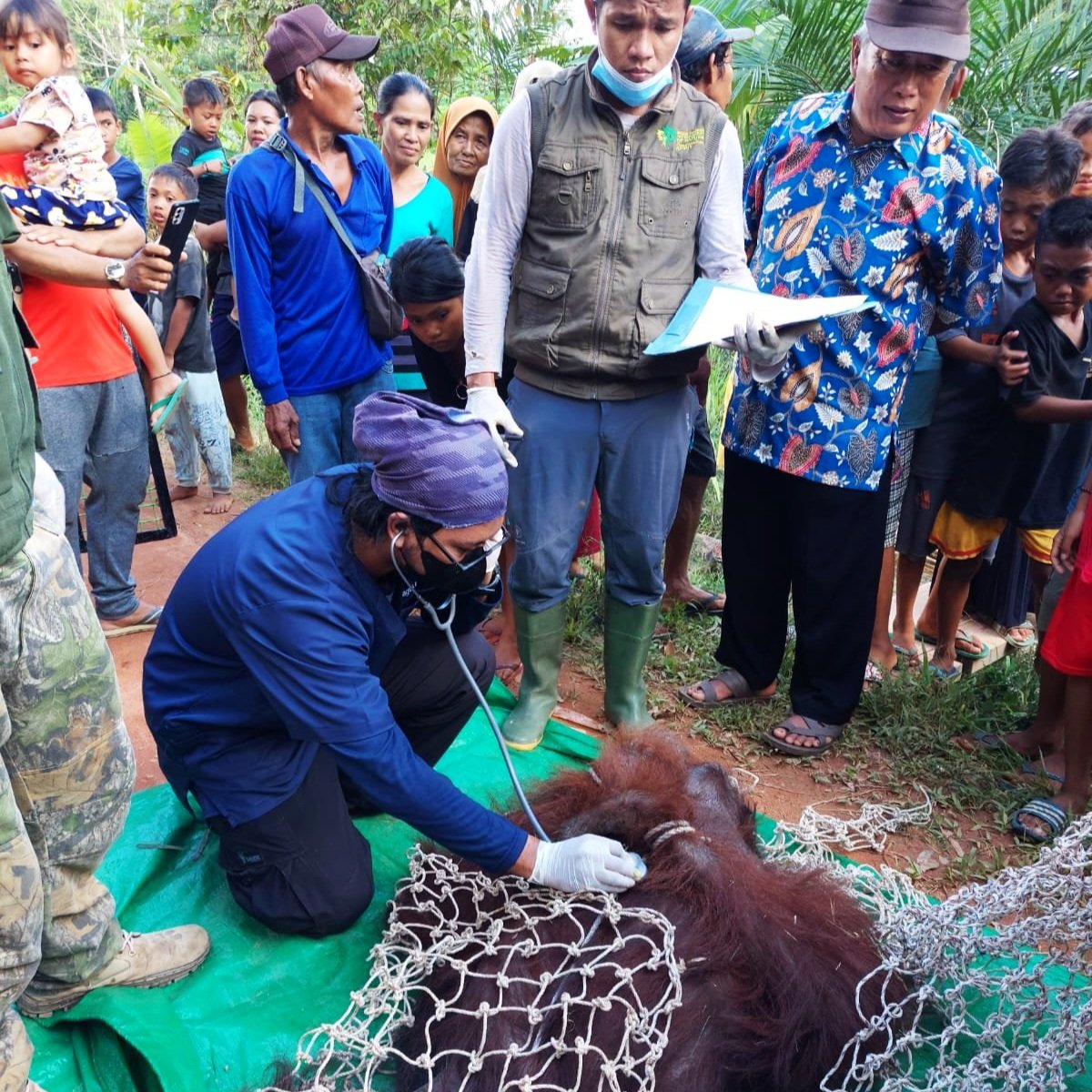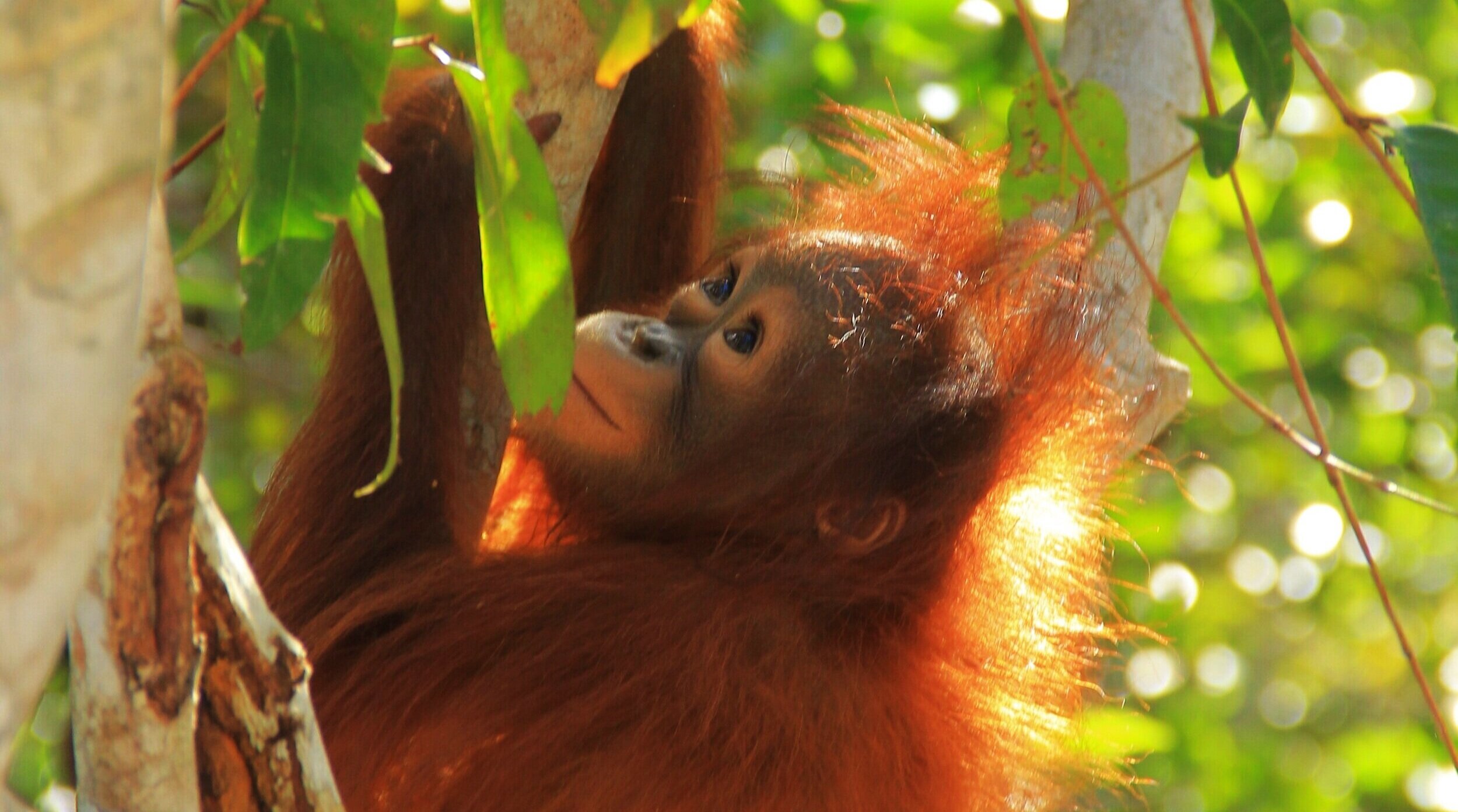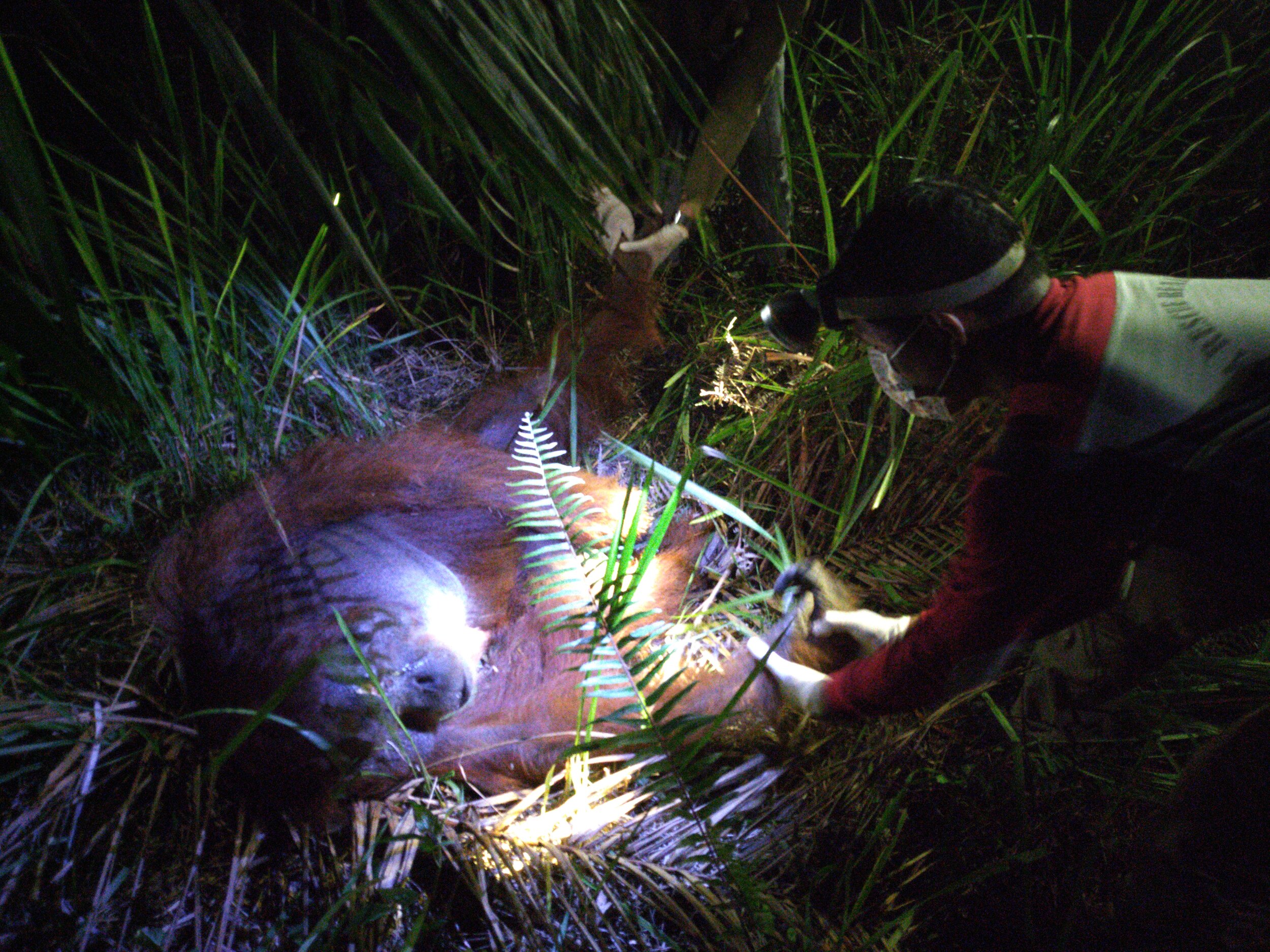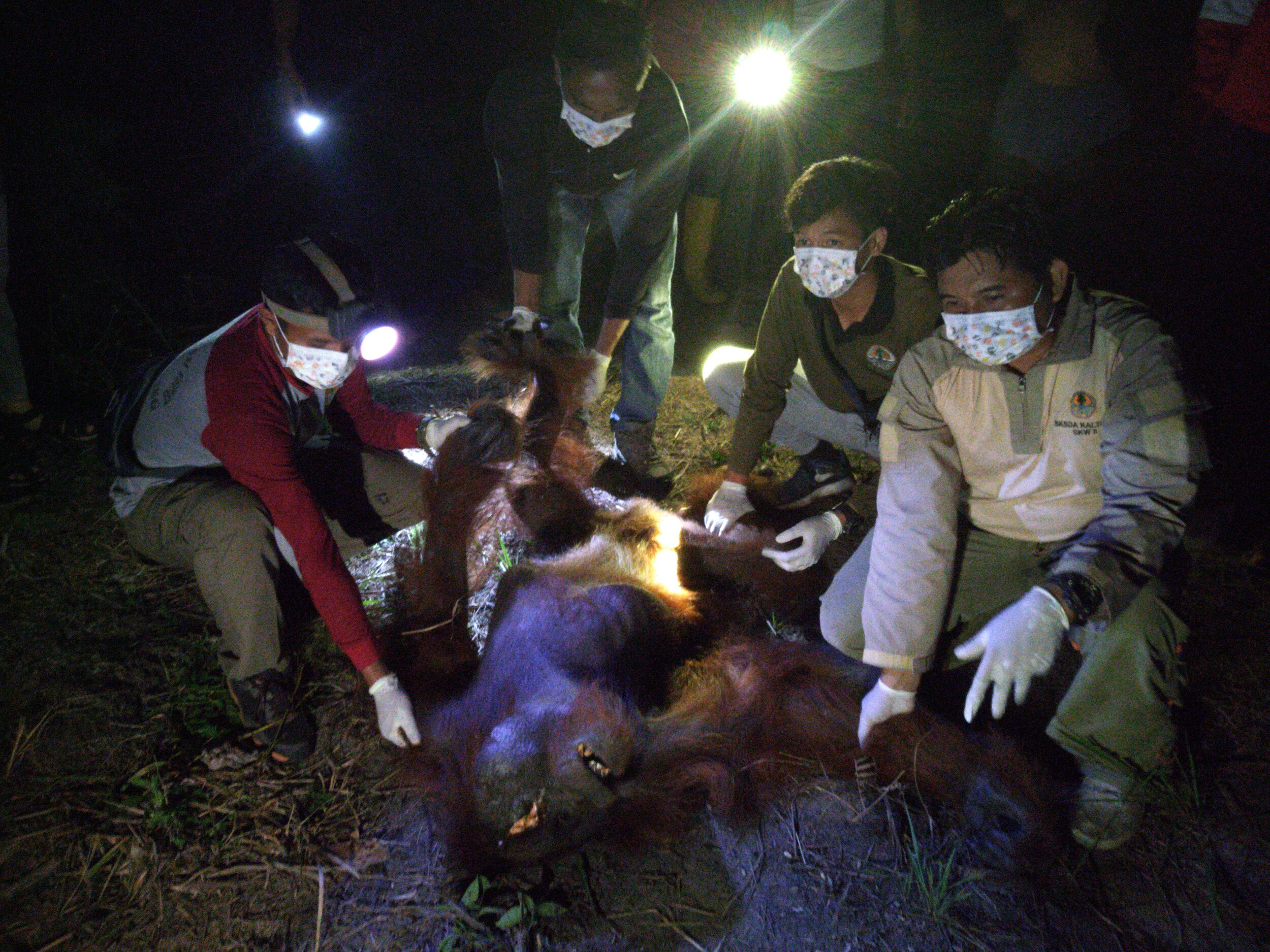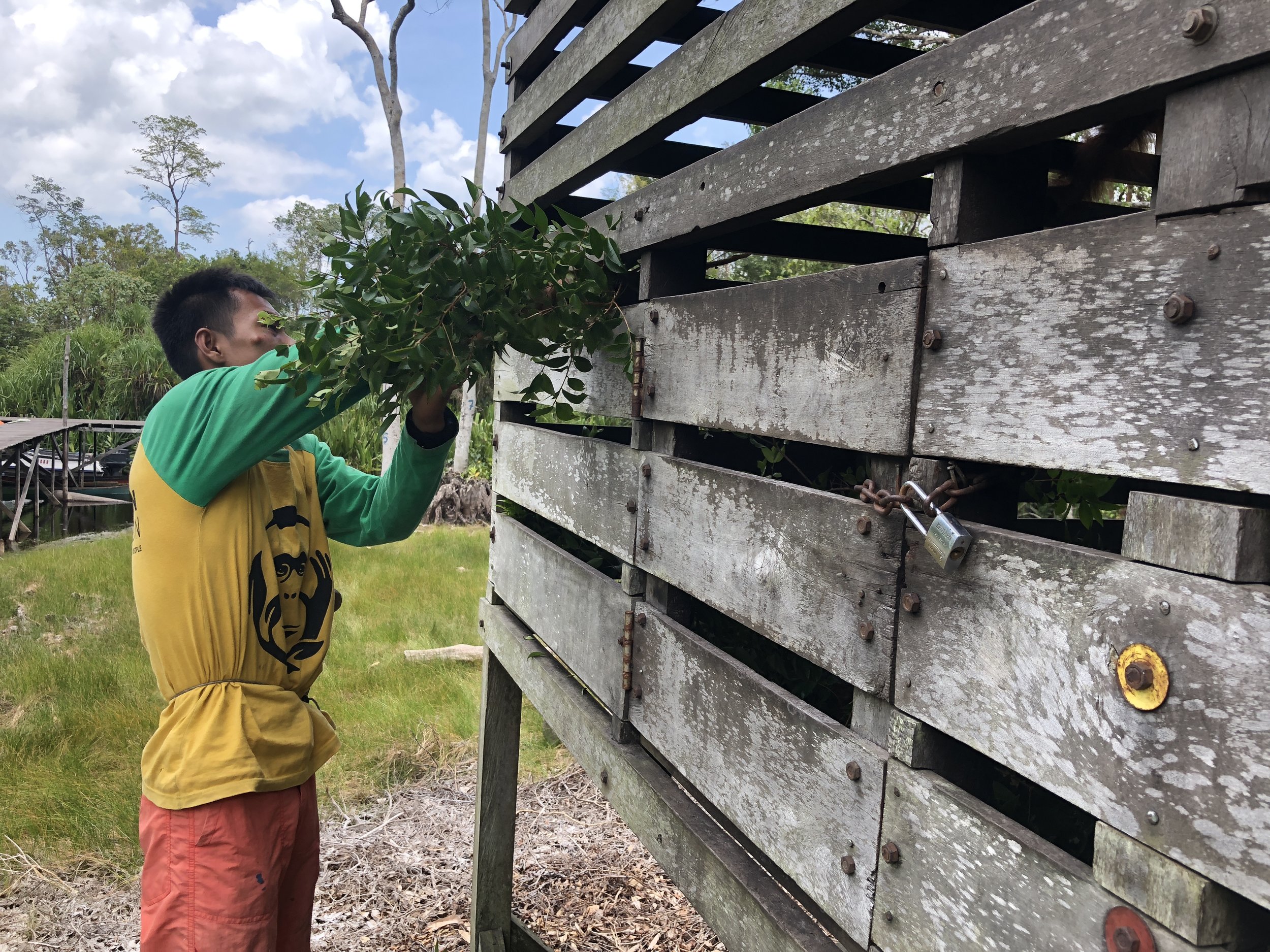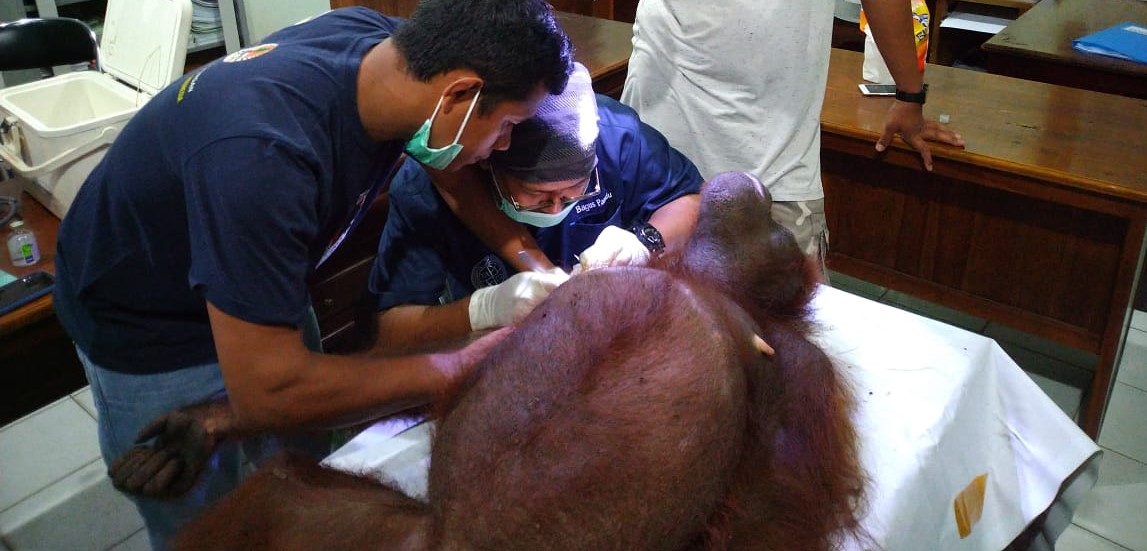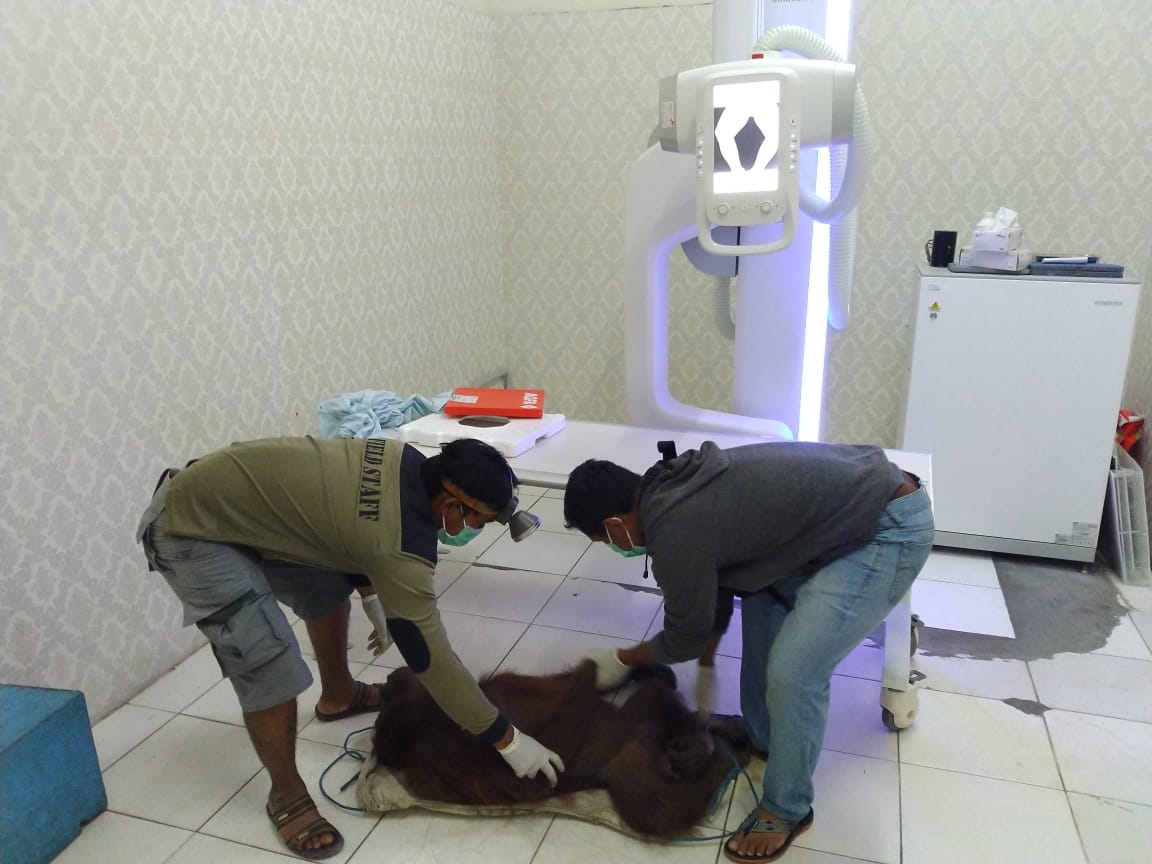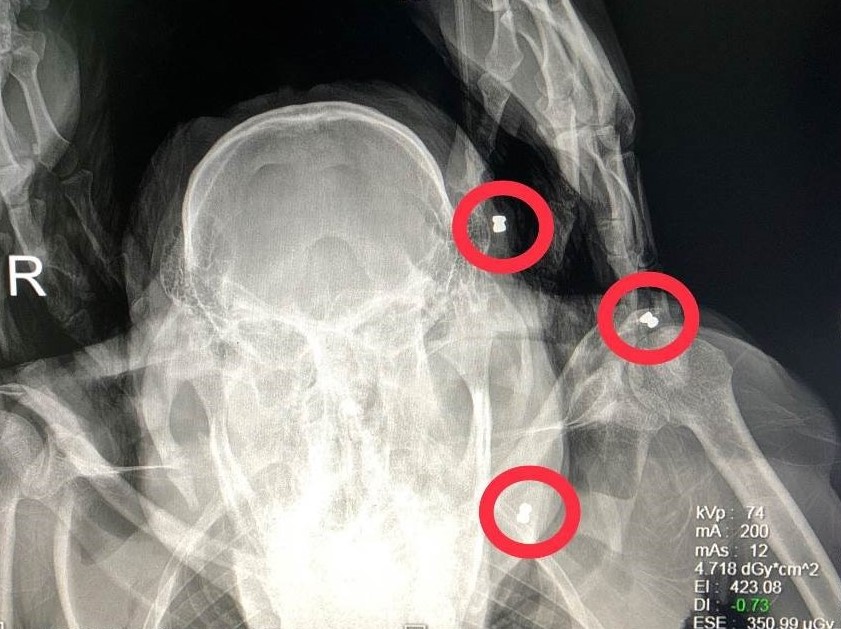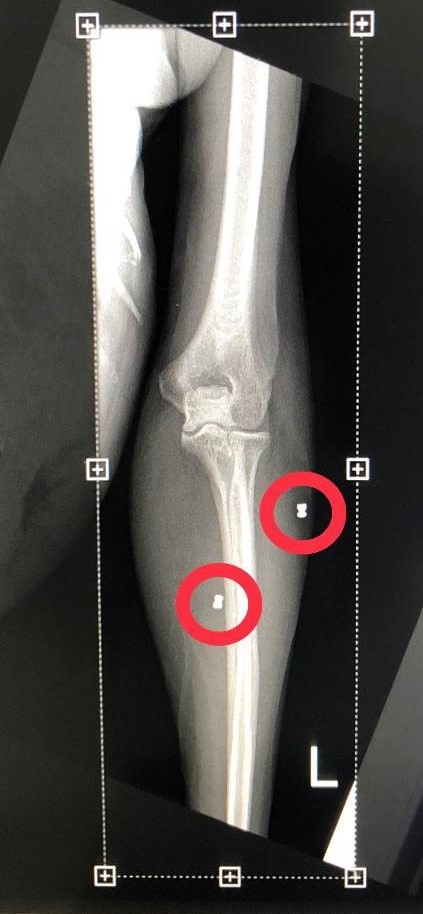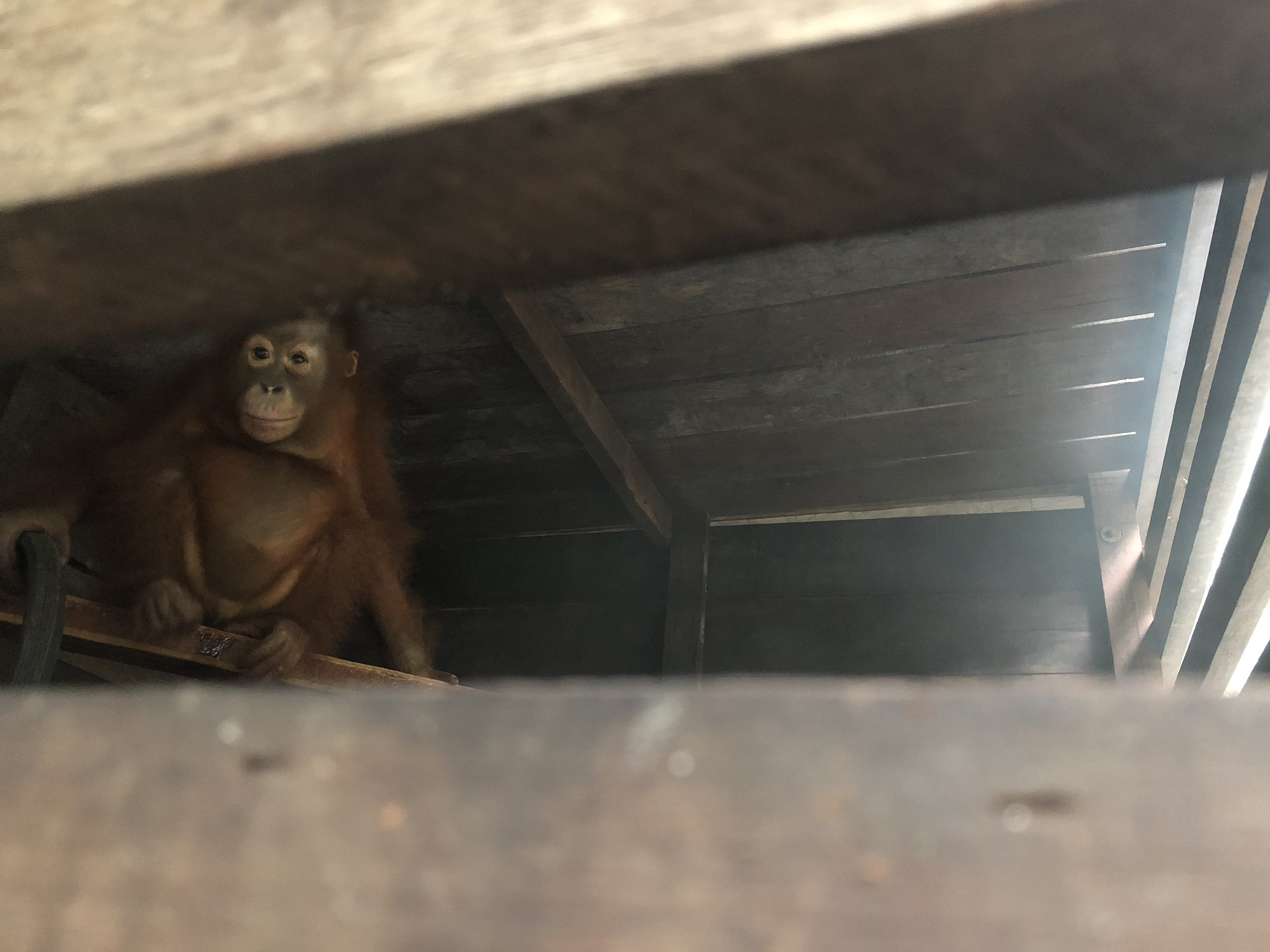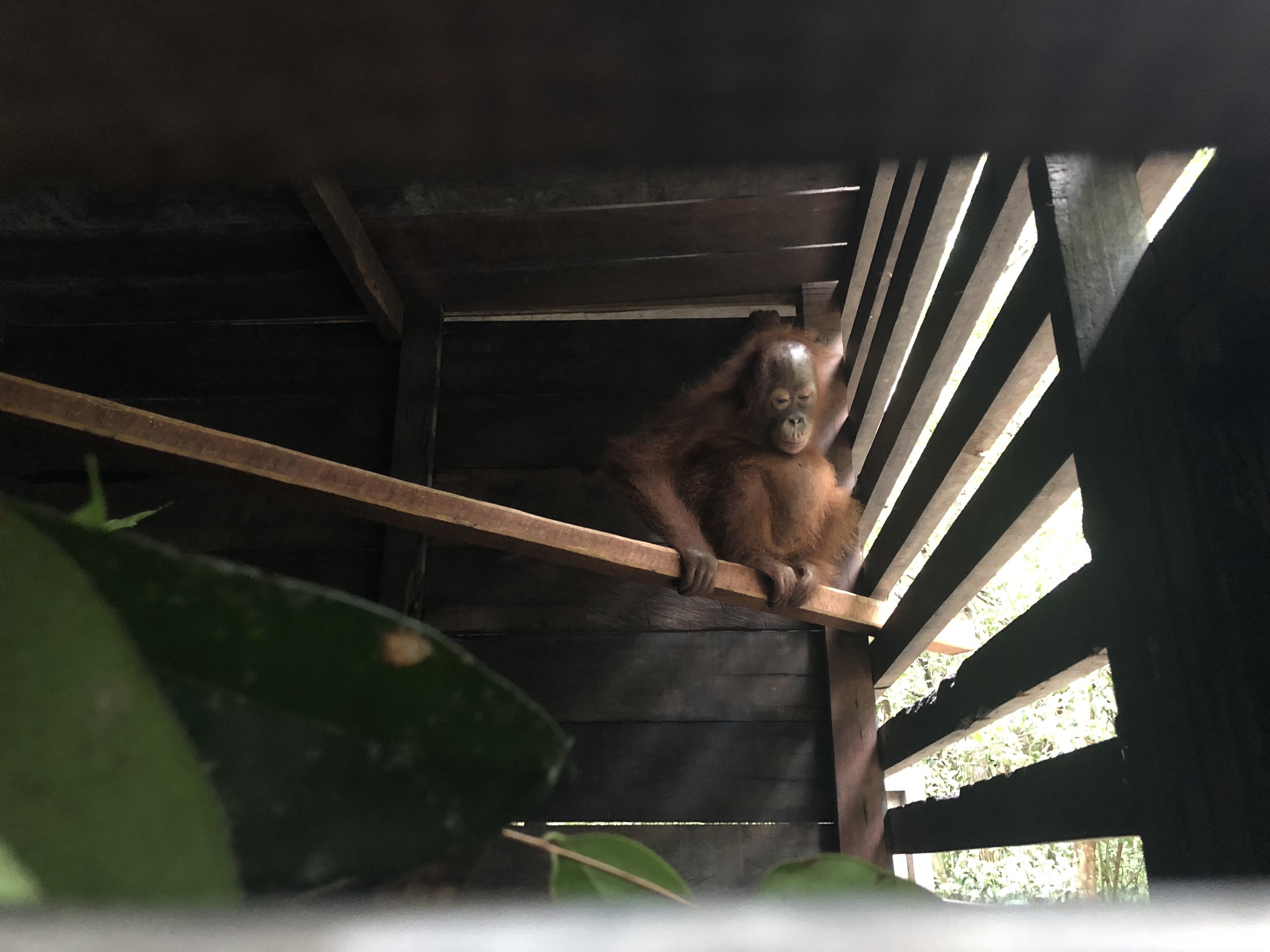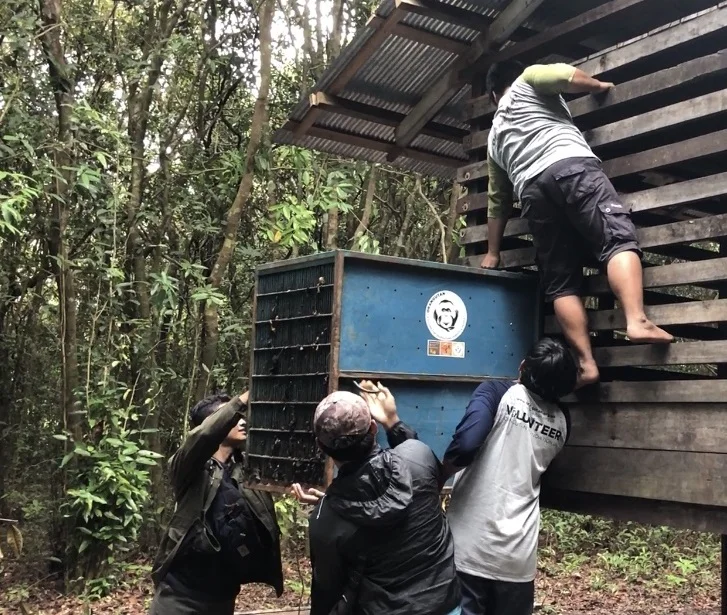The reappearance of long-lost orangutan, Andy! In this orangutan story we explore where Andy has been, as well as his unusual upbringing as an adopted orangutan.
Orangutan Stories: Batuah
In our latest remarkable orangutan rescue, we’re reminded not only of the challenges facing this critically endangered species, but also the dangers imposed on our wildlife rescue team. Everything doesn’t always go to plan:
Many residents of the small village of Batuah in Central Kalimantan, Borneo, rely on farming as a source of food and revenue. Situated on the outskirts of Sampit, the largest town in the area, Batuah sits beside tropical forest and is therefore frequented by wildlife from time to time.
Over the past year or so, one villager had been keeping his eye on a male orangutan that seems to reside in the forest nearby. That was until recently when the primate was seen a few days in a row in their orchards eating pineapples and jackfruit. To avoid a potentially hazardous encounter, it was time for government officials BKSDA and Orangutan Foundation’s rescue team to swing into action.
Arriving at the scene, our team could see that they might have a struggle on their hands. Although the orangutan showed no aggression, he was clearly a large and imposing figure, and surrounded by many villagers. For his safety he needed to be tranquilized and translocated to an area where he could roam freely.
Carefully the 55kg male was darted, captured safely in a net, and given a brief once over by our vet. It needed the help of some local people to lift the orangutan and get him into his transport crate. At first sight he had many cuts on his feet, most likely from sharp rattan and rubber trees in the plantation, but more worrying were the number of bullet wounds found on his skin. It’s unclear whether these came from residents of the village or further afield, but before he could be released into the wild, we would need to investigate the great ape’s injuries in more detail without so many people around.
The orangutan was given the name Batuah, after the village, and transported to offices in Pangkalan Bun for inspection. Unfortunately, eight rifle-pellets were found still lodged in Batuah’s skin so he would require minor surgery before being eligible for release.
For his operation, Batuah received an anaesthesia injection to send him to sleep but the large male was still moving while being taken to the surgery table. Carrying out treatment on such a powerful animal is extremely dangerous if they’re not completely anaesthetised so a second half-dose was required to make sure Batuah wouldn’t feel a thing. One, two, and then three pellets were successfully removed without incident, until our vet noticed something- Batuah was starting to move again!
For the safety of everyone involved, the team made the quick decision to end the surgery there and then. Batuah was hurriedly moved back into his transport crate where he could wake up in peace, and thankfully it appeared that the remaining pellets in his skin were not causing any pain or limits to his movement. With another day to gather his strength and recover from his surgery, the great ape would soon be ready to go back to the wild.
The next day our team carried Batuah in his travel crate onto a speed boat and took him upriver into the safety of the Lamandau Wildlife Reserve. They were thrilled to see him dart out of his cage on his release and then sprint up into the forest canopy, safe and free. In his new home, Batuah can roam in confidence without the need to take food from plantations as if he’d never left the forest.
His story is one that perfectly summarises the challenges facing most orangutans in the wild today. The growth of human activity must expand into something, and in many places, it encroaches into forests which in turn leads to more human-wildlife interactions and conflict. The fact that Batuah can now survive in a protected habitat makes him one of the lucky ones, but as our towns and farmlands continue to expand, the number of rescues required will only increase.
In fact as we go to print, we’ve received news that a gibbon has also been rescued from a nearby village having been kept as a pet for seven years. It’s hoped this primate will also be released into the Lamandau Wildlife Reserve.
Orangutan Stories: Labetty and Suwita
Forget the wet and dry seasons, for the orangutans of the Lamandau Wildlife Reserve at the moment it appears to be baby season! Following the news of Pauline and Queen both giving birth in recent weeks, we are thrilled to report two more additions to the forest from first-time mothers Labetty and Suwita.
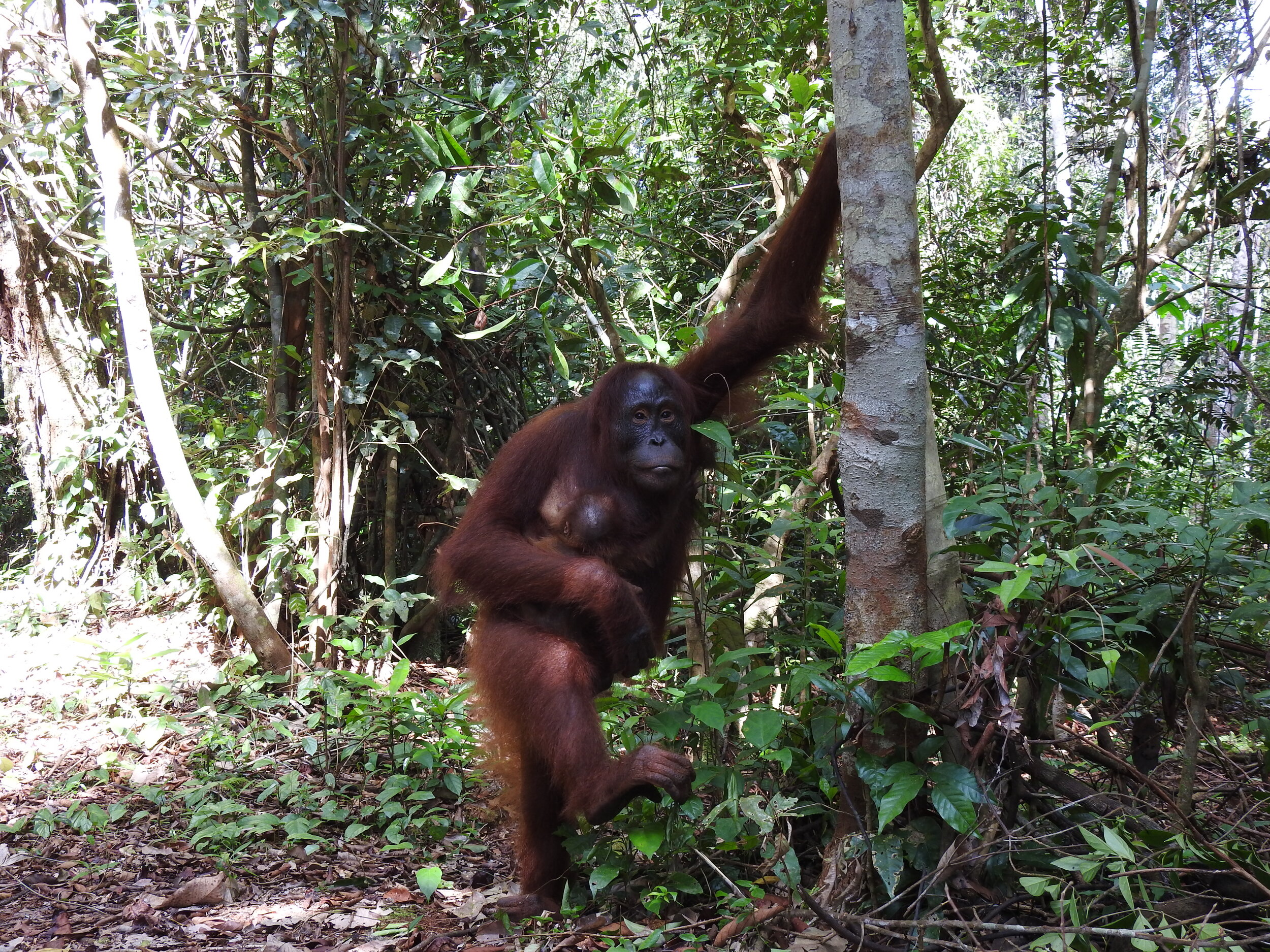

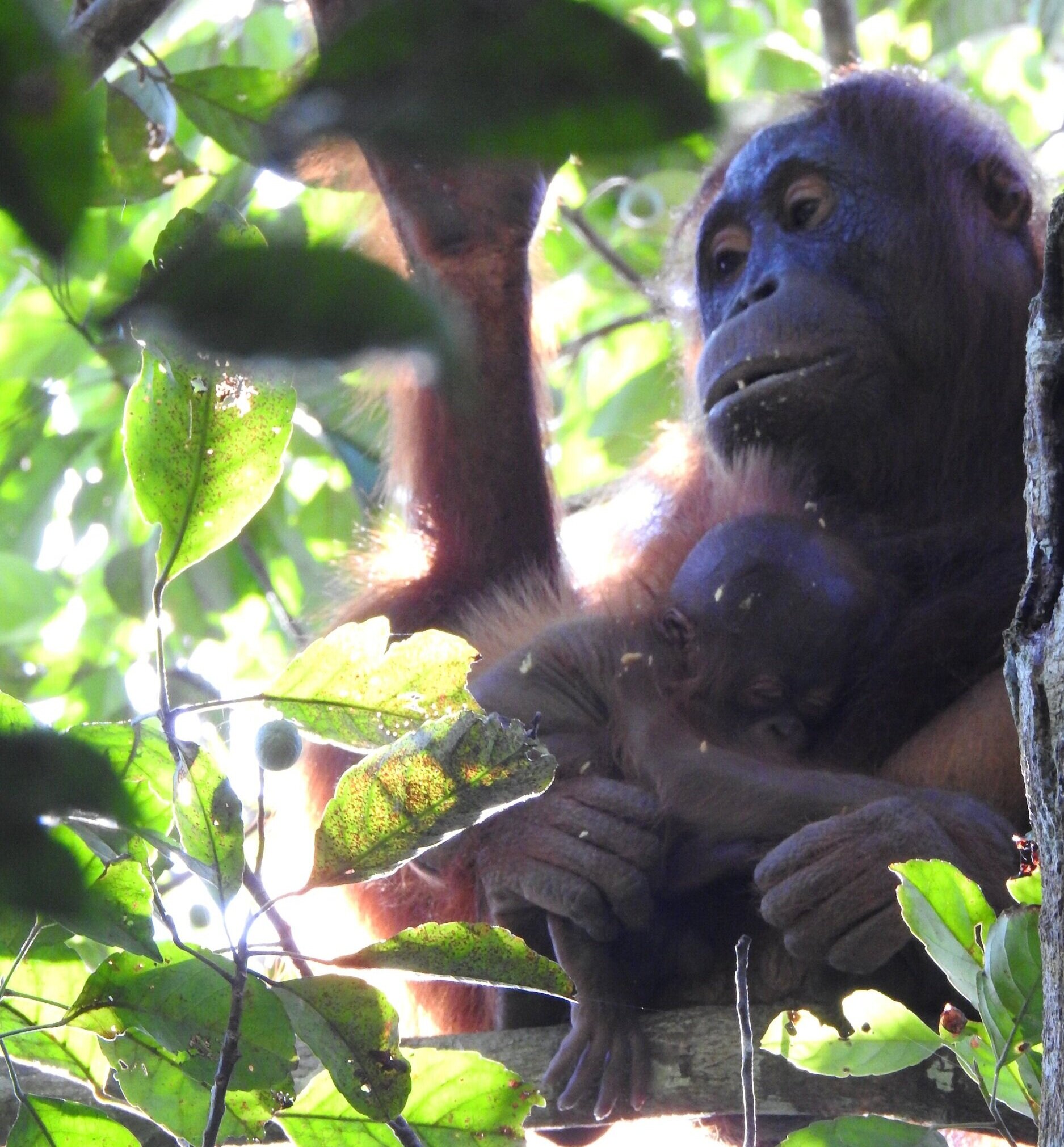
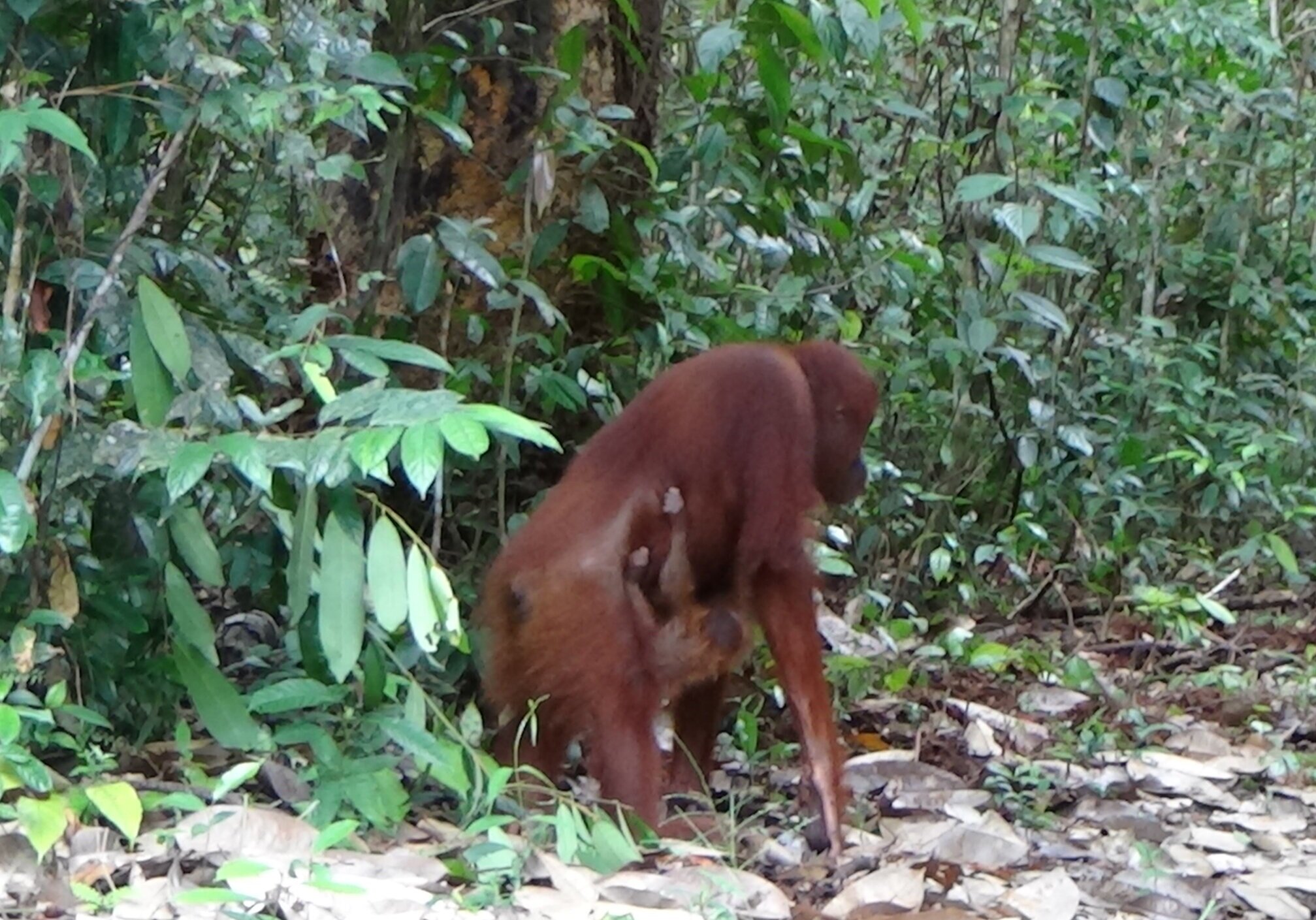
It’s not always easy to identify a pregnant orangutan as the signs can be subtle, but in recent months our teams have been keeping a watchful eye on a handful of females who appear to have slightly enlarged bellies, genitals and appetites; one of whom has been Labetty (above).
Labetty is a wild orangutan who our team at Camp Rasak have been observing on her occasional visits since her birth in 2007. Despite her larger size in recent months however, Labetty still appears to be one of the fastest orangutans in the forest and seems to glide through the trees with speed and elegance, regardless of her pregnancy. It was predicted that Labetty would give birth in around a month’s time so it was somewhat of a surprise when she was spotted this week with her new baby, identified as a male.




It would be fair to say that Suwita (above) has also surprised our team this week. It wasn’t until relatively recently that Suwita was identified as another pregnant female, but the duration of her gestation period was unknown. With wild orangutan males Ewet and Tole also spotted from time to time at Camp Rasak, it was thought that one of these males (most likely Ewet) must have mated with her at some point, but when? It wasn’t until this week when Suwita was observed with her young infant that our team knew she must have mated around 9 months ago.
The sex of Suwita’s new baby is currently unknown but our field team and veterinary staff will continue to monitor the progress of her and Labetty in the coming months. We look forward to collecting and sharing footage of the pair caring for their new infants in the forest very soon.
Through their new infants, Suwita (left) and Labetty (right) are contributing to a more secure future for this orangutan population.
To witness four wild orangutan births within a matter of weeks is a remarkable achievement and demonstrates how settled this population of great apes is in the Lamandau Wildlife Reserve. For all of us at the Orangutan Foundation, this news truly feels like a fitting reward on the 30th anniversary of our conservation work, supporting these critically endangered primates and protecting their natural forest environment.
Cause for celebration! The first orangutan birth of the year
It was with great excitement and surprise that Orangutan Foundation staff recently caught a glimpse of Pauline, a wild orangutan rarely seen at Camp Gemini, proudly displaying her new two-week-old baby boy.
Our team are thrilled to welcome the first newborn orangutan of the year, and the first offspring for new mother Pauline. Her infant has been named 'Pancaran' by Ibu Siti, the local Minister of Environment and Forestry. It’s heartening that in the Lamandau Wildlife Reserve, orangutans have provided us with some recent good news and encouragement for the future.

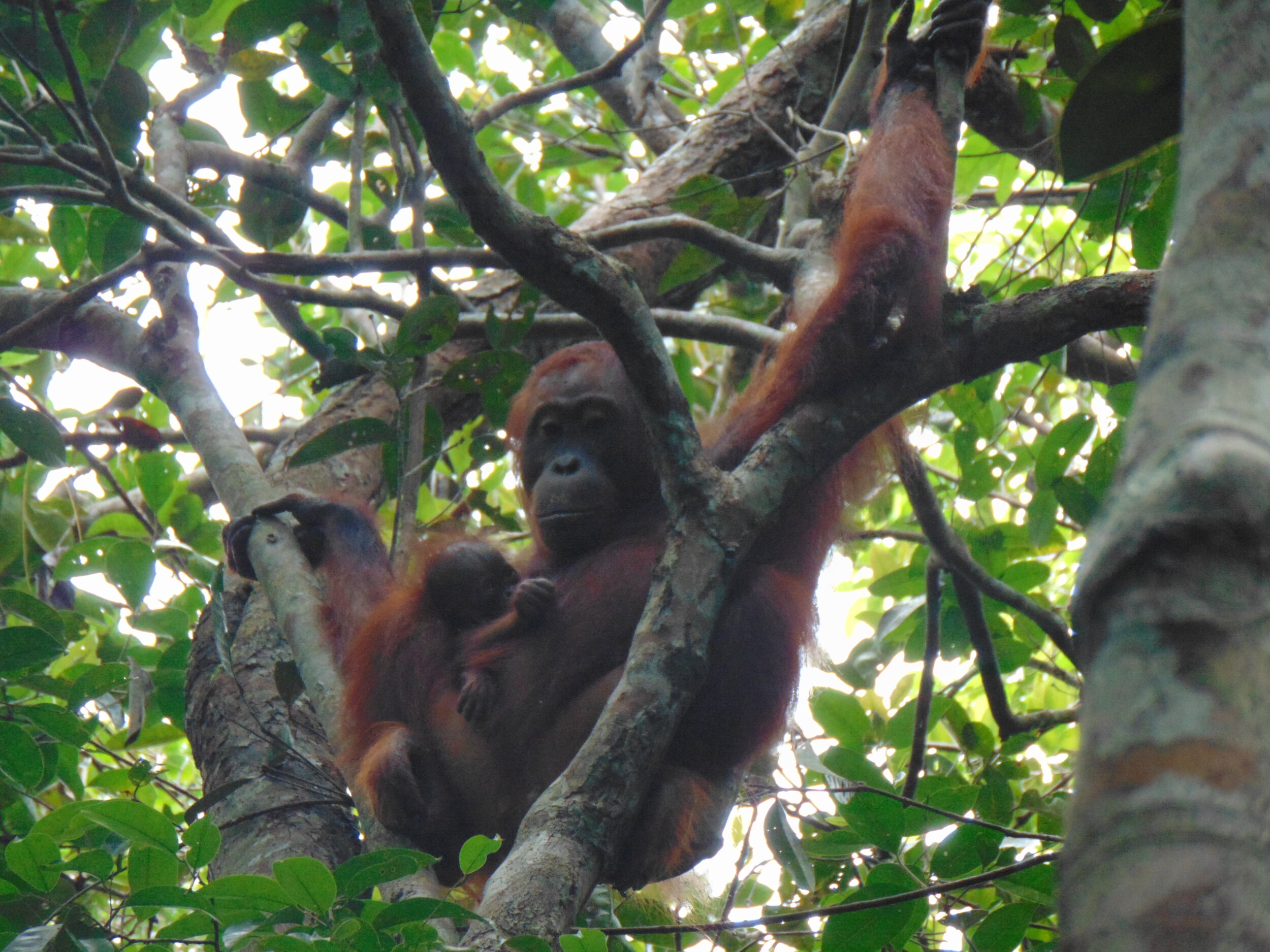

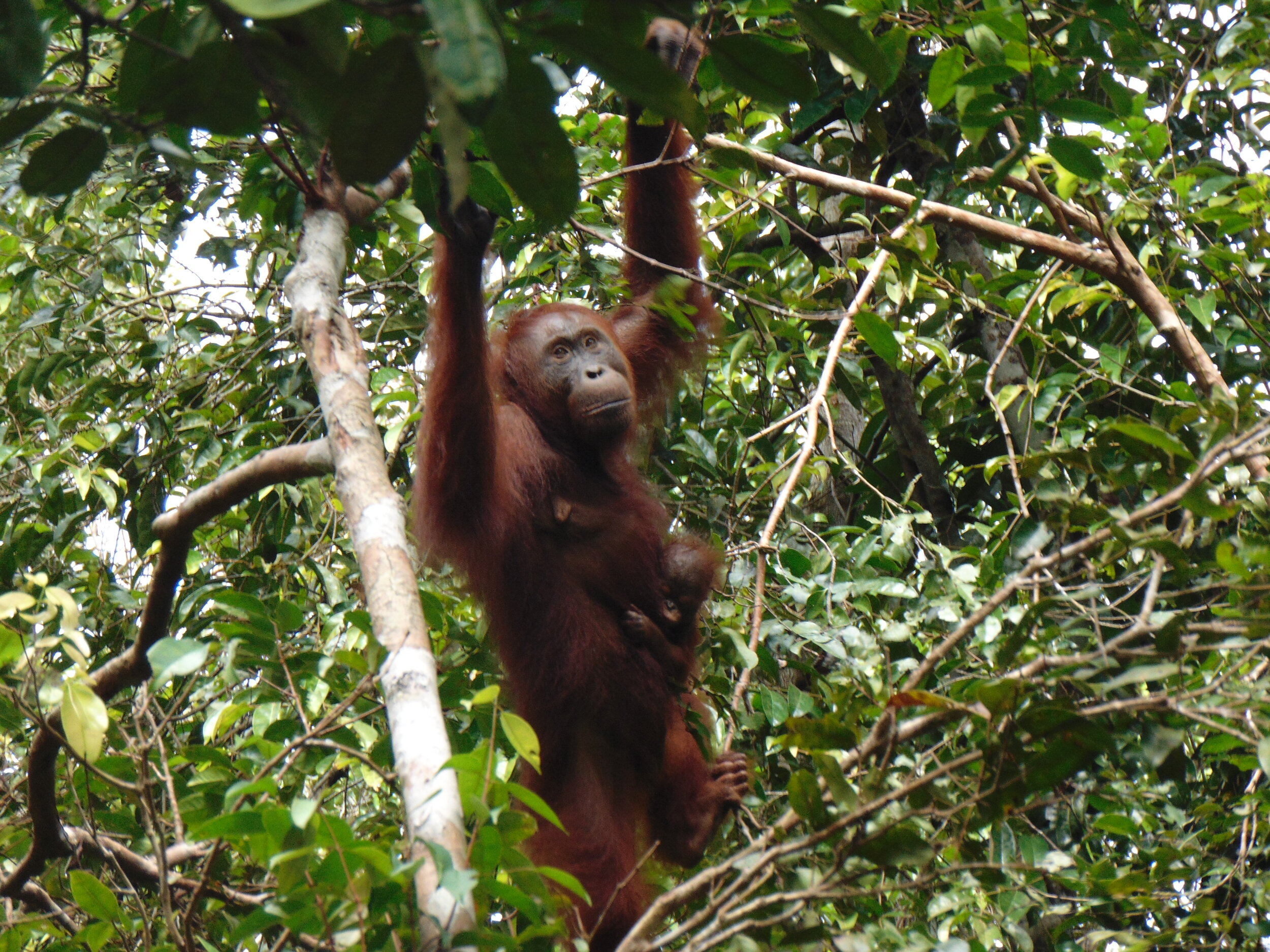
Pauline is the thirteen-year-old daughter of reintroduced orangutan Paula, and spends much of her time in the forest. It’s thought that last year Pauline mated with Carlos, a wild male orangutan who is also sporadically spotted at Camp Gemini. What is just as exciting is that she may not be the only orangutan with a newborn this year, as four other females in the forest also appear to be pregnant.
Betli and Queen have extended bellies and are eating for two at Camp Buluh
Our field teams keep a close eye on all of the wild and reintroduced orangutans that visit our five forest camps in the Lamandau Wildlife Reserve, but are keeping particularly close tabs on Labetty and Suwita at Camp Rasak, and Queen and Betli at Camp Buluh who may all be expecting newborns soon. Hopefully providing a bumper year for orangutan births in the forest.
Despite her pregnancy, Labetty is still a speedy climber though the forest
Orangutans take many years to rear their young, which is why having observed 15 births in the past five years alone, our team are proud to see that the Reserve is clearly a habitat in which these critically endangered great apes are not only surviving but thriving. We will continue to protect this vital orangutan stronghold, and look forward to welcoming more new arrivals in the coming months.
Orangutan Stories: Adib
Adib is the youngest male orangutan among the ten orphans currently in Orangutan Foundation’s soft-release programme. Despite his young age, Adib has experienced and endured a great deal in his early life.
Once entered into the soft-release programme, Adib takes his first ever climb into the trees.
Adib was raised as a pet until he was rescued in 2017 at around one and a half years old. Orangutans of his age in the wild would be entirely reliant on their mother in order to learn necessary forest skills and receive proper nourishment. With the likelihood that his mother was killed, it was therefore vital that Adib should receive appropriate care in the Foundation’s soft-release programme and develop in a natural environment.
Adib shares his current surroundings with four other orphans at Camp JL within the protected forest of the Lamandau Wildlife Reserve, Indonesian Borneo. Each morning these young primates climb out of their overnight enclosures and enthusiastically swing between branches, forage for food, and practice nest-making skills around camp. With no mother to keep a watchful eye on them, it’s the role of our expert team of assistants to ensure that these orphans stay safe.
When climbing high in the canopy is involved, there is always a danger to these adventurous young orangutans and accidents can still happen, as Adib discovered himself in December 2018. As he practised his climbing by stretching between branches in the trees, Adib accidentally fell to the ground and appeared to be in some discomfort. Following emergency X-rays, our vet Dr Dimas discovered that Adib had a small fracture in his right arm and required a temporary cast in order to hold it in place.
Fortunately at such a young age Adib’s bones are able to heal more rapidly, and ten days after his accident, he was able to grip fruit and hold onto camp staff as they held him.
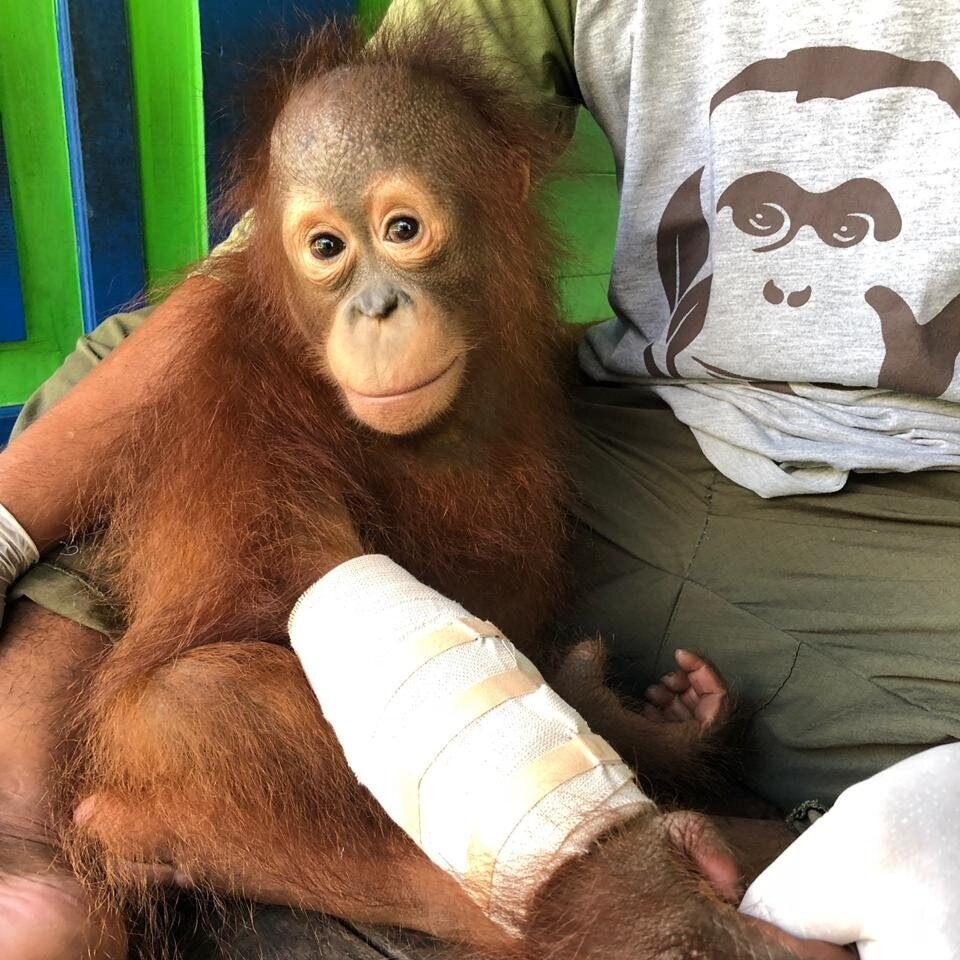
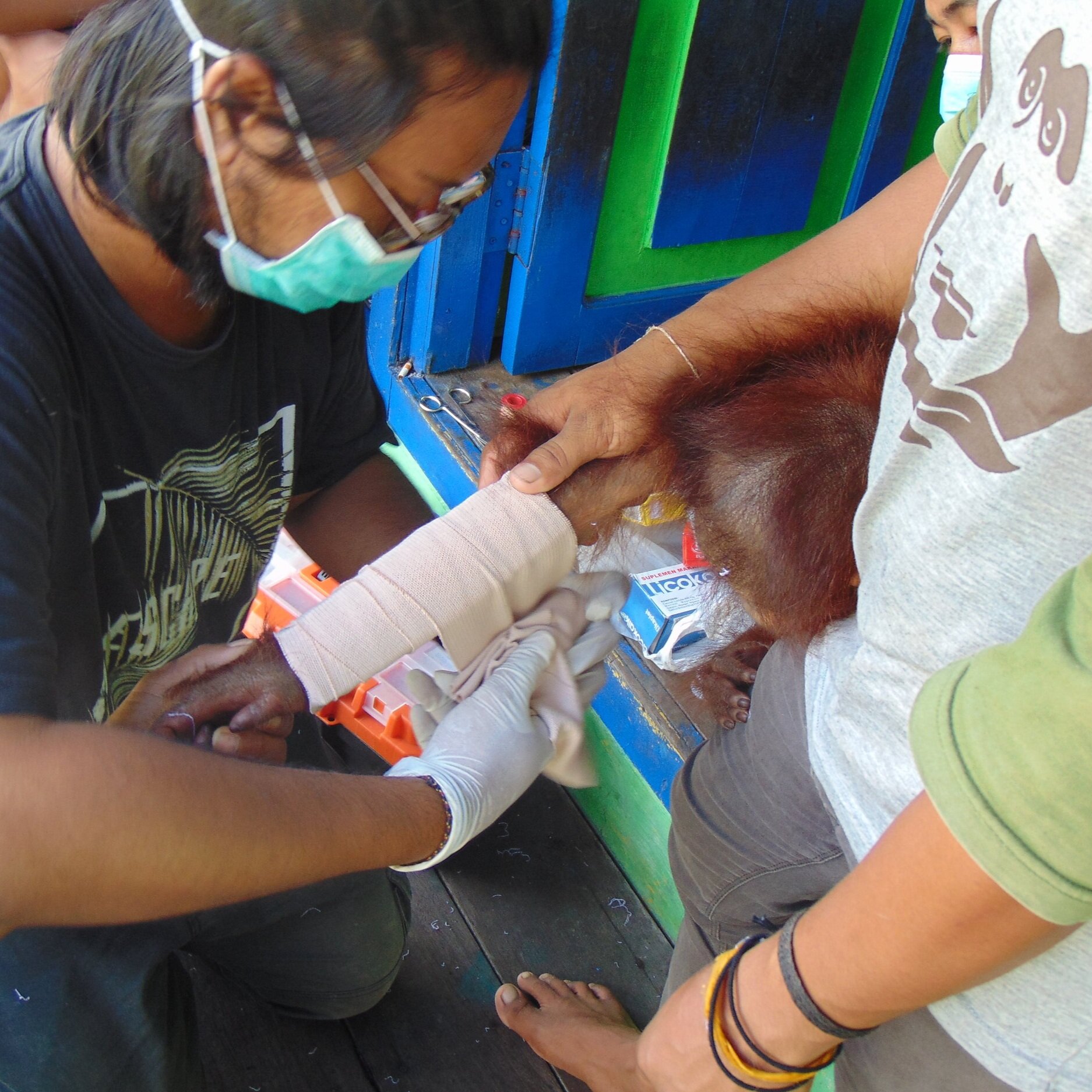
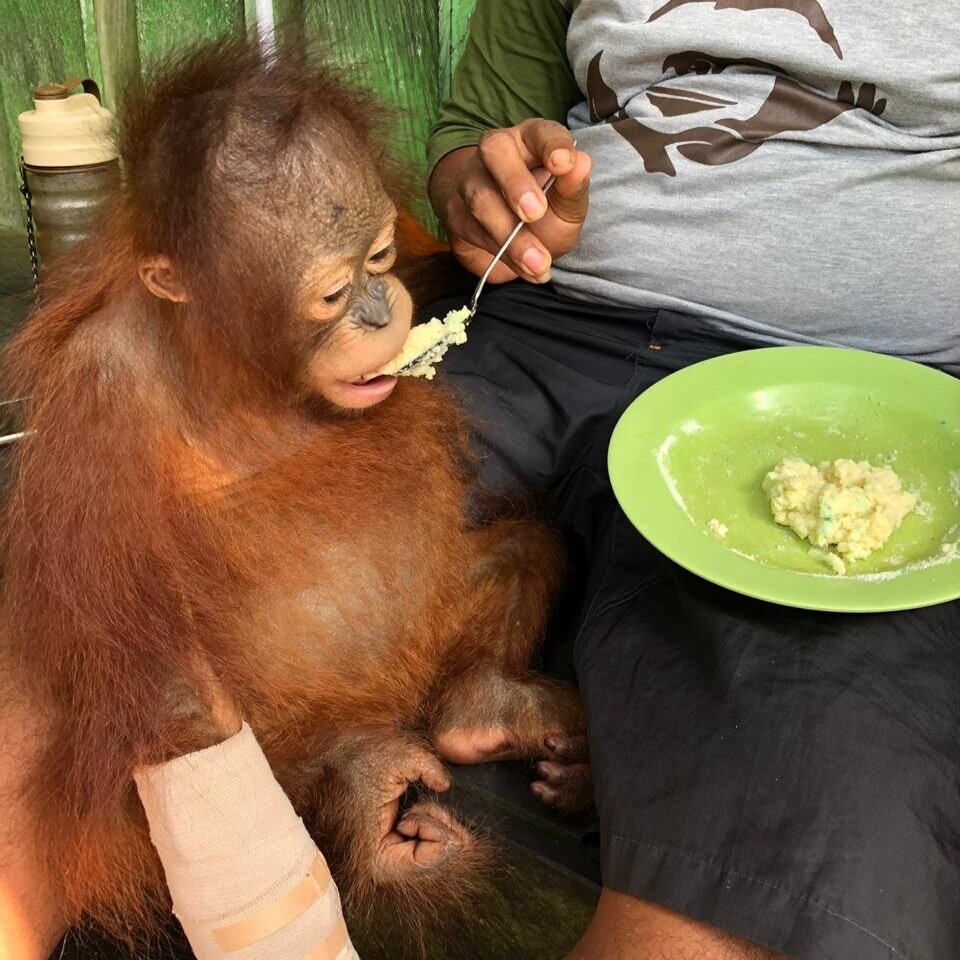
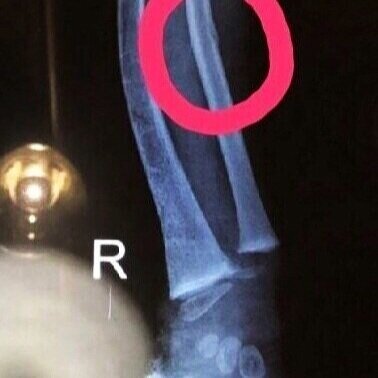
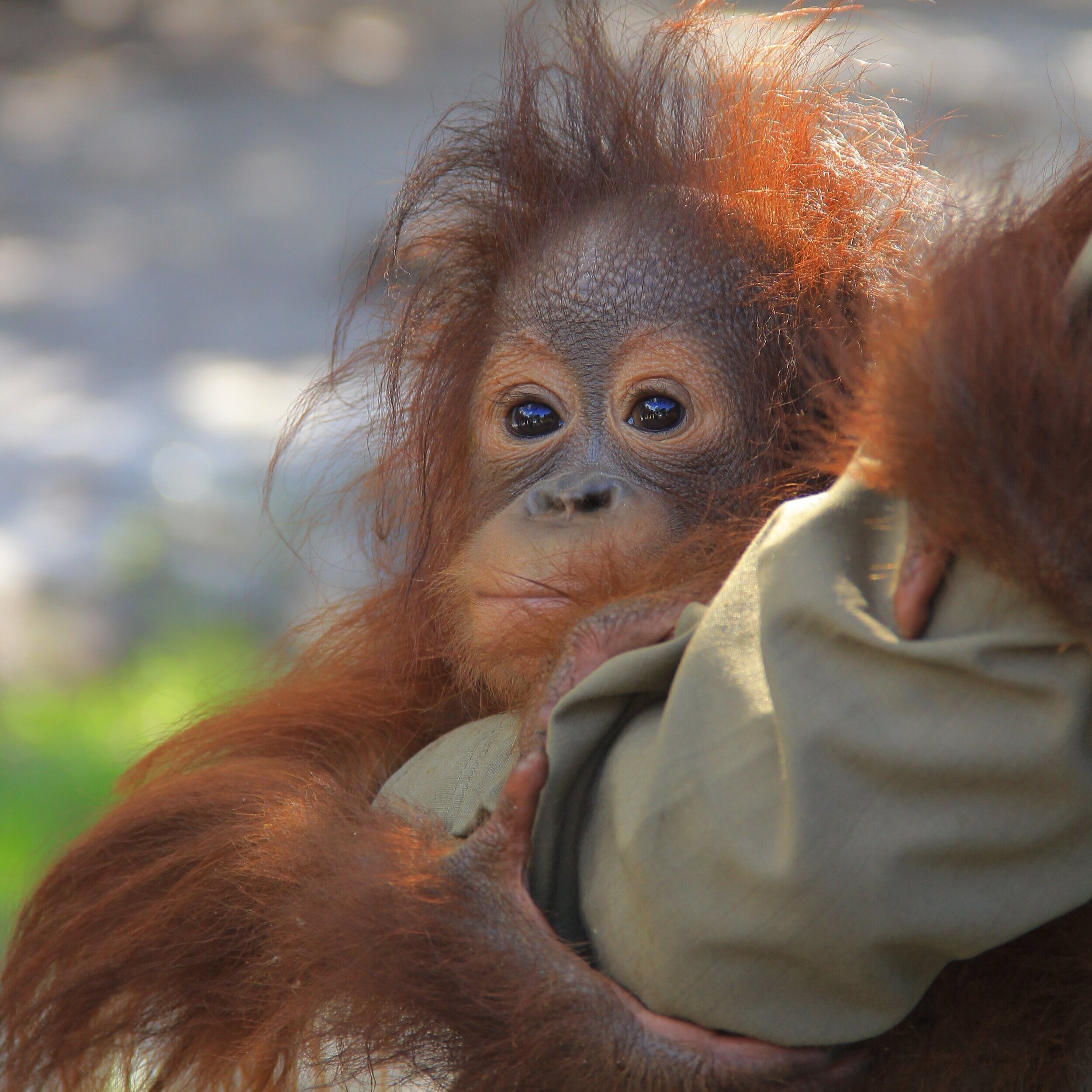

Despite what must have been a painful time for Adib, it hasn’t stopped him from being adventurous and active in the forest today. Now at 4 years of age, he’s beginning to master the art of climbing through the trees in search for food, but still has some time to go before he becomes an expert nest-builder.
Our team are encouraged by the progress Adib has made since his time in the Foundation’s orangutan soft-release programme and look forward to the day that he will be fully prepared for an independent future in the wild.
Orangutan Stories: Pegi
Each month we will be unveiling a story about the orangutans we care for at the Orangutan Foundation, and this month we focus on Pegi. Pegi is an adventurous young orphan who in her short time with us has transformed from a shy and nervous orangutan to one that is confident in the trees. So much so that recently Pegi evaded our team at Camp Buluh for two nights and stayed in the forest on her own for the very first time under the watchful eye of our team.
Pegi before she was rescued as a pet, and after she entered the Foundation’s soft-release programme.
Before entering our orangutan soft release programme within the Lamandau Wildlife Reserve, 8-year-old Pegi was a pet. In August 2019 she was handed over to government officials and Orangutan Foundation staff having spent the previous seven years alone inside a cramped wooden cage, during which time she was never released. She was also fed on a diet consisting of rice, noodles, fruit, and sugary drinks, conditions far from acceptable for a young critically endangered primate.
Spending so many years away from a forest it might be understandable to assume that Pegi would have lost any natural impulses, but as she is proving to our team of orangutan assistants, her wild instincts are very strong and she is quickly understanding and practising the skills necessary for a life in the wild.
When Pegi first arrived at our soft-release site in the forest, she was anxious of the water around camp. Now, one of her favourite things to do is take a gulp of water and spray it into the air!
On the morning of the 26th April, Pegi was taken out of her overnight enclosure by our team as usual to allow her to climb in the trees, eat bark, and play in the water. However later that morning Pegi decided to explore a little further than normal and follow a reintroduced female orangutan named Sugih into the forest.
Our team struggled to keep an eye on Pegi as she played high in the canopy, but in the afternoon she did something to surprise everyone, she began making her own nest. This is something that Pegi has never been observed doing before at camp, and sheltering from the rains that had swept over the forest, our team where amazed to see Pegi stay in her nest and sleep in the trees alone for the first time overnight.
With Orangutan Foundation staff keeping watch from below, Pegi continued her adventure through the forest the following day. Playing in Sugih’s nest and climbing from tree to tree, Pegi was observed eating young leaves, flowers, and fruits before adding more branches to her previous nest and settling down for another night in the forest.
This independent experience for Pegi shows how much she has progressed since her arrival last summer, however there are still abilities that need to be mastered before she is fully prepared for a life in the wild. With this in mind, our team were able to climb up Pegi’s tree on the afternoon of the 28th April and transport her back to camp where she can complete her education.
Pegi certainly appears to have the instincts for a future in the forest, and we hope that by refining her skills with fellow orphaned orangutan Okto, the pair will soon be able to be released from Camp Buluh together into the protected Lamandau Wildlife Reserve.
Wild orangutan rescued with severe injuries
On Saturday 30th November, our field team received an all too familiar report. Government officials BKSDA had alerted the team that an orangutan had been found with possible injuries by residents in an area adjacent to an oil palm plantation in Central Kalimantan, Indonesian Borneo.
Arriving at 9pm later that evening following a long journey to the reported site, our rescue team were met by the sound of dogs barking in the distance. They were alerted to the location of the great ape by one of these dogs who was owned by a local employee of the nearby oil palm plantation.
The orangutan is found on the ground before being sedated
On first sight of the orangutan, it was upsetting for our team to see that it was in a great deal of distress. Unlike the majority of orangutan rescues, it was unusual to see that this individual was not in a tree but instead on the ground.
Identified as a male orangutan, who when approached could only move a short distance along the ground due to his very weak state. After spotting multiple injuries on his body, our vet Dr Dimas and the team wasted no time in sedating the male and transporting him to a safer location where he could be examined thoroughly.
Dr Dimas prepares medication for the male orangutan
Weighting around 75kg and at an estimated 25 years of age. The most horrifying of his injuries was a large laceration to his left eye- an injury which will have blinded him.
Once sedated, rescue teams can begin examining the male
Clearly the orangutan had been shot in the past as multiple rifle pellets were found embedded in the skin; in both cheeks, the hip, and in the back of the neck. Sadly a further two larger pellets were also discovered in his left elbow which could have fractured or broken the bones in his arm on impact. Vitamin and antibiotic injections were administered to help fight infection
The orangutan receives a thorough medical examination
The poor condition of the orangutan’s wounds indicted that his injuries may have been made just a few days beforehand. It’s distressing to see that after all this time, incidents of human-wildlife conflict continue to occur.
In collaboration with BKSDA government officials, our team will continue to closely monitor the progress of this unfortunate male at a facility where he can receive essential medical attention. It’s disheartening for the team to witness this individual in such a horrifying condition.
Mother and baby orangutan rescued and reunited
Following on from the 6 individuals who have been rescued and translocated since mid-July, Orangutan Foundation staff in Central Kalimantan, Indonesian Borneo were alerted to yet another emergency earlier this month.
Reports from BKSDA government officials suggested that an orangutan had been found by a group of villagers who had discovered the great ape when it ventured into an area of community plantations- quite possibly searching for food as a result of the remnant fires that have blotted the region in recent weeks.
On arrival, our team were able to observe that the orangutan was a female who had already been independently captured by the local people and put inside a transport crate. Explaining that this action should only be conducted by trained personnel, Orangutan Foundation staff then began their journey back to base with the orangutan in toe. However as our team were to soon find out, this was not the end to this orangutan’s story.
Shortly after the rescue our team received a worrying piece of news. It transpired that during the capture of the female orangutan, she had also been separated from a young infant that local residents wished to keep as a pet. Fortunately however, Orangutan Foundation and BKSDA officials were again on hand to rescue the orangutan baby from the community and reunite it with its mother.
Our vet was very pleased to see both orangutans in good health following medical examinations and observe the infant immediately feeding once reunited the mother. The 16-year-old female who had been given the name Kina, appeared to be very active as she breastfed Kino, her 2-month-old son.
Kina is anesthetised and undoes her medical examination
A few days after their initial rescue, our team were so relieved to see Kina and Kino immediately take to their new forest at the Lamandau Wildlife Reserve as they quickly climbed out of their transport cage into the trees. It’s always an uplifting experience for us to release orangutans back into the wild where they belong, and then for them to behave as if they’d never left.
On the other hand however, it is a concern that today we are still seeing orangutans in need of rescue, and perhaps more worryingly that some local communities remain keen on keeping these great apes as pets.
Kina and Kino race out of their transport crate into the protected Lamandau Wildlife Reserve
Caged for 7 years. Young orangutan kept as a pet is finally offered a lifeline
It’s never a phone call we wish to receive, but in the same week that our team rescued a pair of wild orangutans from an isolated oil palm plantation, we received news of another orangutan being kept as a pet also in need of rescue. The owner had contacted government officials as they could no longer care for the ape, and therefore Orangutan Foundation staff were called upon to assist.
Arriving at the property where the orangutan was being kept in Central Kalimantan, Borneo, it quickly became apparent that the individual had been kept there a very long time. Our team tentatively approached a wooden crate with litter strewn on the ground surrounding it.
The orangutan had been named Pegi by her owner. It transpired that Pegi was a female orangutan found as a 1-year-old in 2012 and incredibly had been living in her cramped wooden crate as a pet for the following 7 years on a diet of rice, noodles, fruit and sugary drinks. Certainly not a diet suitable for orangutans.
After obtaining as much information about the young orangutan as possible and informing the owner of the prohibitions around keeping wild animals’ captive, our team freed Pegi from her cage and transported her to a government facility (BKSDA) where her health could be inspected.
Fortunately under examination Pegi seemed in good health, and as her blood tests received the all-clear, she was ready to be taken to her new home at Camp Buluh in the Lamandau Wildlife Reserve. It’s here that she’ll join another orphaned orangutan, Okto, in our soft-release programme, with the hope of one day being released into the wild.
The early years of any orangutan’s life are the most important in order to learn how to survive in the wild. With Pegi’s traumatic start to her young life, and perhaps never even climbing a tree before, she will need encouragement to learn these skills in the best possible training ground there is- the forest.
Pegi is given some browse as a form of enrichment
Orangutans rescued from oil palm plantation marks International Orangutan Day
While people around the world celebrated the red ape this week, our team have had a busy few days spent rescuing orangutans in need. To go behind the scenes and understand some of the challenges still facing orangutans, our team in the field have put together a timeline of our most recent orangutan rescue:
Friday morning- It was reported to government officers this week that an orangutan had been spotted within a community oil palm plantation in Central Kalimantan, Indonesian Borneo. Once the location had been determined, our orangutan rescue team were then called upon to assist.
Friday 11:45am - On arrival, a female orangutan was observed with an infant in an isolated copse of trees, entirely surrounded by oil palm plantation. With the dimensions of this tiny patch of fragmented forest being a mere 10x20 metre area, and any suitable nearby forest considered too far away for the pair to travel, a decision was made to rescue them from this remote island of trees for their safety. In practice however, the strong winds and height of the trees made tranquilising the female a very difficult task, and it wasn’t until several hours later that the pair were finally safely brought down from the canopy.
Friday 6pm - With the light beginning to fade, and the female orangutan under sedation, it was the role of the veterinary team to perform a quick physical examination to check the health of the pair. Under initial inspection, it was observed that they were in relatively good health except the mother had several air rifle pellets embedded in her skin, and therefore required further attention. As the night drew closer, the pair were then carefully transported to a temporary facility for them to rest.
Sunday evening - In honour of Indonesian Independence Day on the Friday, the 16-year-old female orangutan had been called Augustine, and her young, who had been identified as a 2 or 3-year-old male, named Augusta. They had both rested and recuperated from their rescue, and now our team were required to act fast to try and observe the number and severity of Augustine’s gun pellet injuries.
Sunday 9pm - In order to monitor the number and location of the bullets in Augustine’s skin, she was taken along with Augusta to a nearby public hospital so that she could be X-rayed. After being safely anesthetised, she was found to have 7 air rifle pellets lodged in her skin.
Sunday 10:15pm - It was at this point that our veterinary team, alongside government officials, began the minor surgical procedure of removing as many bullets as possible from Augustine. The delicate operation was able to remove 5 of the pellets, with a further 2 too deeply embedded into her tissue to be able to safely extract. Fortunately, Augustine appeared to come out of the hour and 15 minute procedure in good health.
Monday 2pm - As the previous evening’s medical procedure had run so smoothly, the following day after a final check-up from our team, Augustine and Augusta were given the all clear to be released back into the wild. A safe area within the Lamandau Wildlife Reserve was selected as an ideal relocation site as this region is protected by Orangutan Foundation guard posts, and after a short boat ride, the pair were happily released into the forest. Once their transport cage was opened, our team were able to catch a quick glimpse of the orangutans before climbing into the nearby trees.
It’s encouraging to know that Augustine and Augusta will now be able to thrive in their new protected habitat. However, witnessing these orangutans initially stranded in the last remaining forest due to habitat loss, shows hows orangutans remain under threat and that the work of the Orangutan Foundation is still needed.
To find out how you can become a Guardian of Lamandau and protect Augustine and Augusta’s new home, please explore our website.
Two rescued orangutans returned to the wild
Two critically endangered orangutans are now back in the wild, where they belong, thanks to the dedicated work of the Orangutan Foundation’s team and the Natural Resources Conservancy Agency of Central Kalimantan (BKSDA).
Both orangutans were wild born but tragically ended up orphaned and rescued by Orangutan Foundation. Shifa was rescued from being kept as a pet in September 2016, when she was only 2-years-old. Panglima, was rescued at the end of March 2019, from community forest, he is thought to be about 5-years-old but showed extremely wild behaviour (read more about his rescue).
Shifa rescued in September 2016
Habitat loss is forcing wild orangutans into closer contact with humans. We can’t say for sure what happened to the mothers of Shifa and Panglima but it is most likely they were killed, because they were considered as pests. As an infant, Shifa would have been clinging to her mother and so she was taken to become a pet. Panglima, being older and more independent, must have been apart from his mother when she was killed.
Panglima rescue by Orangutan Foundation and Wildlife Department (BKSDA) Central Kalimantan
Shifa was taken to the 158,000-acre protected Lamandau Wildlife Reserve, Central Kalimantan, Indonesian Borneo. She lived at Camp Buluh, one of five post-release monitoring sites in the reserve, which she shared with another orphaned orangutan, Okto. The two young orangutans were great playmates and Okto helped Shifa to adjust to her new life.
Okto (left) and Shifa (right)
Shifa always displayed very wild instincts and, as she got older, these became stronger and more evident. Increasingly she would go off exploring the surrounding forest and was reluctant to return to her enclosure at night.
Shifa in her nest and increasingly reluctant to go back into her enclosure.
It was decided to release Shifa before she released herself! When an orangutan is fully released back to an independent life, Orangutan Foundation staff follow the individual for up to two weeks to ensure the orangutan is able to survive. Ashley Leiman OBE, Orangutan Foundation Founder and Director/Trustee, was present for the two releases and was encouraged to see how readily both orangutans clambered up into the trees to begin their new life.
As soon as the transport cage door opened, Shifa shot straight out and climbed up the nearest tree
Shifa and Panglima have had to overcome massive hurdles early on in their life. Our challenge now is to ensure the rest of their life is spent in the wild. We are doing this by safeguarding their globally important forest habitat in Lamandau Wildlife Reserve. Orangutan Foundation actively monitor the reserve with a network of guard posts and regular patrolling to prevent illegal activities from destroying the forests and harming wildlife.
Why play is important for young orangutans
The orphaned orangutans in our soft-release programme in Lamandau Wildlife Reserve, Central Kalimantan, Indonesian Borneo, are taken out to play in the forest every day. Play-time is crucial for the young orangutans as it allows them to watch and learn from each other. Together, they find food and build nests. Play helps to build up their strength and climbing skills. This video, taken recently, show’s Mona “at home” in the forest. Just watch how she uses her hand-like feet and every-which-way hips to move with such ease and confidence.
The next video clip shows Nyunyu eating bark with Mona (above right) watching and joining in.
Rescued orangutan soon ready for release back to the wild
When Panglima was first rescued he wouldn’t use the tyre swing or browse in his enclosure - the team looking after him felt sure he would but it would take time for him to adapt to his new surroundings. They were right!
Panglima, a rescued wild Bornean orangutan is very wary of humans.
These images show Panglima using the swing and he gathers up browse (the branches and leaves he is given) and makes a nest.
Panglima using his tyre swing and browse
He eats plenty of fresh fruit and is active and healthy. He is still wary of humans and moves away when someone approaches the enclosure, but this is behaviour we want him to retain.
Panglima is a wild orangutan and though he is quite young he will be released back into the wild in June. He’ll be followed by our post-release monitoring staff. If he needs it he will have access to supplementary fruit. Watch this space for an update on his return to the wild.
Though still young Panglima is very wild and he will be better off living in the forest.
Update on rescued 5-year-old wild orangutan
Yesterday our vet, Dr Dimas, and our reintroduction manager, Mr Azhari, visited Panglima, the five-year-old wild orangutan, who we rescued last week. Panglima is temporarily being kept in isolation at Camp Siswoyo, in Lamandau Wildlife Reserve.
The staff at Camp Siswoyo provide leaves and branches every day as an enrichment. He doesn’t use the tyre swing but we’re sure he will as he adapts to his new surroundings. Panglima rests on the enclosure floor but as soon as anyone approaches he climbs to the top of the enclosure. He is wild and it is good that he is wary of humans, which is something we want to maintain. He is eating well and this is also a positive sign.
Young orangutan rescued
Yesterday, we rescued a young orangutan, aged approximately 5-years-old. Sadly, the mother was absent, we don’t know what happened to her but most likely she has died, mother orangutans would not readily abandon their offspring.
Tranquillised orangutan, named Panglima
The Wildlife Rescue Unit (WRU) team was made up of the Central Kalimantan Wildlife Department (BKSDA) and Orangutan Foundation. The Wildlife Department had received reports about an orangutan seen in a community orchard. The rescue team drove 45 minutes from the town of Pangkalan Bun to the reported location in the Pangkalan Lima area, South Arut District.
Orangutan nest high up in the tree
When the team arrived they saw two nests in one tree, but there was no sign of an orangutan. After a while the team decided to return to Pangkalan Bun. In the afternoon, the team received another report about the orangutan and so they returned. This time they saw a young orangutan very high up in the trees. The team decided to follow the orangutan until it nested in hope they could get a clear shot with the dart gun. Unfortunately they couldn’t and because it was getting dark and unsafe they decided to return very early the next morning, when hopefully the orangutan would still be in his nest.
Preparing the dart gun to tranquillise the young orangutan
Climbing up the tree to rescue the sedated wild orangutan.
The next morning, in the torrential rain, the rescue team arrived at the nest location at 4.30am. The orangutan was found above a nest, not far from where they had left him. The dart gun was prepared so that the orangutan could be tranquillised. They managed to get a clear shot and the orangutan fell into its nest. One of the rescue team climbed a 10-meter tall tree and managed to carry the orangutan down.
The Orangutan Foundation vet immediately conducted an examination and the orangutan was male, weighing approximately 15kg and was estimated at around 5-years-old. Our vet, Dr. Dimas Yufrizar, took blood samples for laboratory tests and gave injections of multivitamins and antibiotics.
The orangutan has been named Panglima (relating to the rescue location) - giving orangutans names helps the field staff with post-release monitoring and communications.
Tranquillised orangutan being examined by Orangutan Foundation vet
Panglima was transported to the Pangkalan Bun BKSDA SKW II office where he is being kept temporarily in a holding cage. Hendra Gunawan, Orangutan Foundation Program Manager said BKSDA have requested that the orangutan be translocated to the Lamandau Wildlife Reserve, a protected area. Before release, Hendra said Panglima will be isolated until his blood tests return and then habituated for three months. His condition will be monitored by the Orangutan Foundation vet and field staff.
The rescue team are confident that Panglima’s release into the reserve will be successful and that he will go on to live a wild and safe life in the Lamandau Wildlife Reserve.
Support our work and join Orangutan Foundation today.
News from the orangutan monitoring release camps, Lamandau Wildlife Reserve
Orangutan Foundation vet, Dr Dimas, has kept a close eye on the healing of Abid’s broken arm. Two-year-old orangutan Adib fractured his arm on 16th December after he fell from a tree.
Two-year-old orangutan Adib’s arm is healing well and he now has a strong grasp.
We are delighted to report that Adib can now grasp the wood in his enclosure and he’s started to play and swing around inside. He shows no sign of pain when his hand is held, and he has a strong grip on the camp staff when they pick him up. Due to his young age his bones will heal quickly and we are sure he’ll make a full recovery and be back in the trees at Camp JL in a week or two.
Okto enjoying the high-water levels at Camp Buluh!
There is no forgetting it is the rainy season in Borneo! Okto and Shifa are certainly taking full advantage of the high-water levels at Camp Buluh.
Orangutan Shifa joining in too.
Shifa is progressing very well and the Camp staff are finding it increasingly difficult to return her in the evenings from the forest back to her enclosure. This is a very positive sign and we are hopeful that we will soon release Shifa from soft-release to an independent life into the wild. Watch this space…
With plenty of fruit in the forest, not many of the post-release orangutans come for supplementary fruit. However, Bangkal, the dominant male orangutan at post-release monitoring Camp Gemini has been seen in the forest. Read more about Bangkal’s extraordinary survival story by clicking here.
Donate to support our work in the Lamandau Wildlife Reserve, Indonesian Borneo.
Wild orangutan rescued and moved to safety
When our staff arrived at the oil-palm plantation they found the orangutan in an area of forest, on the riverbank of the plantation. We had been called in to help by BKSDA SKW II Pangkalan Bun (government agency for wildlife) who had received reports from an oil-palm plantation of an orangutan in their plantation. It was decided to capture the orangutan and move her to the protected Lamandau Wildlife Reserve, to avoid potential conflict.
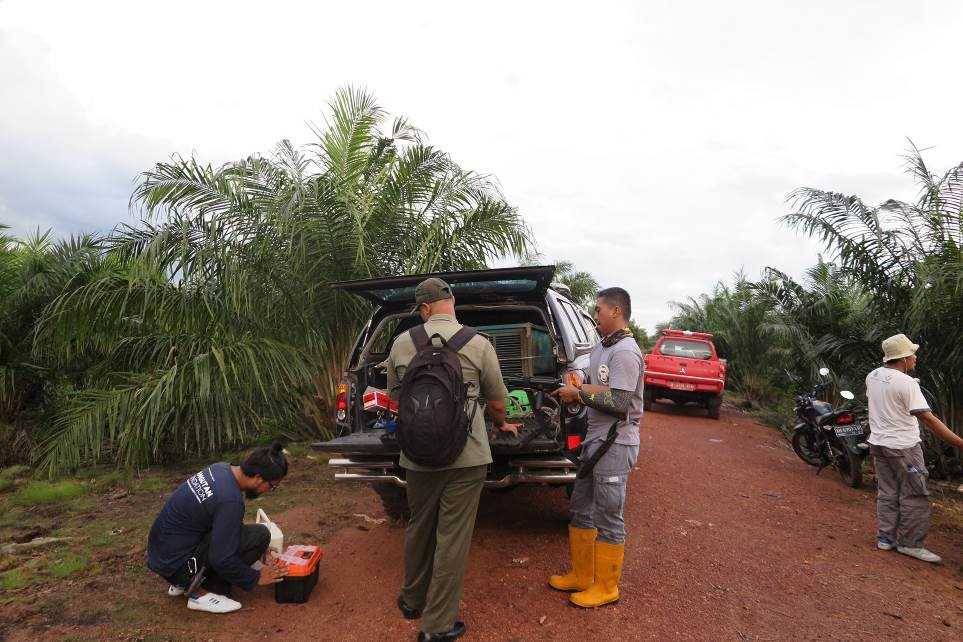
The orangutan, who they identified as female, had made and was resting in a nest. This made it easier to dart her as she wasn’t moving.
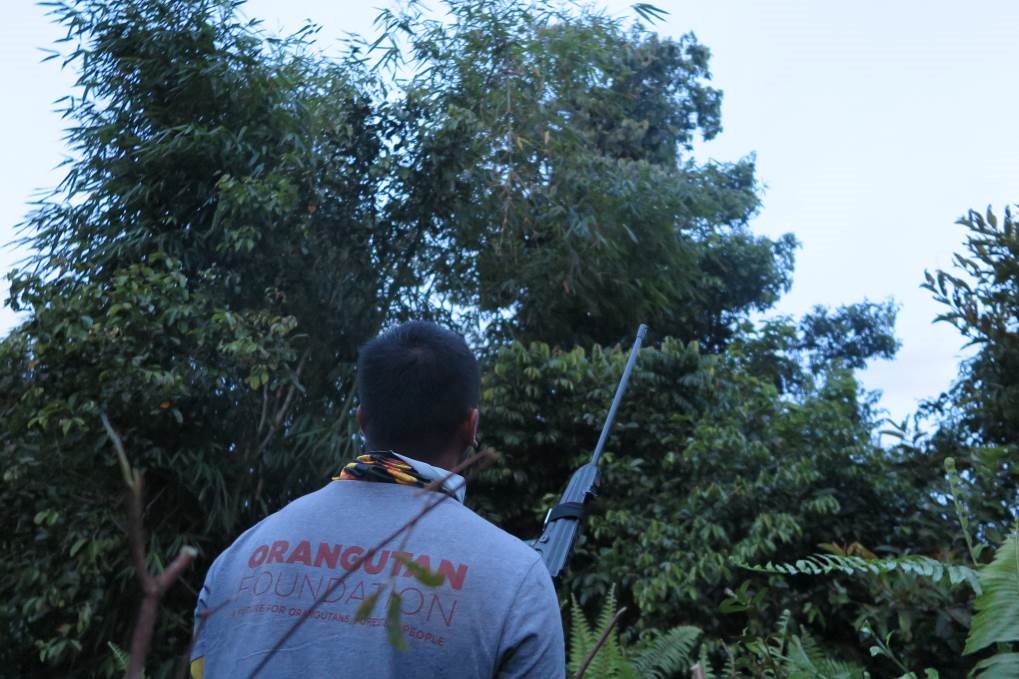
What our staff hadn’t anticipated was that she might just remain where she was and fall asleep, making it very difficult to then rescue her. This is just what happened!
One of our rescue team staff, Mr Nasibah, also an expert tree climber, shinnied up the tree to the nest. With huge effort he managed to lower the unconscious orangutan out of her nest. Our staff on the ground, used netting to catch her, as she fell to the ground.
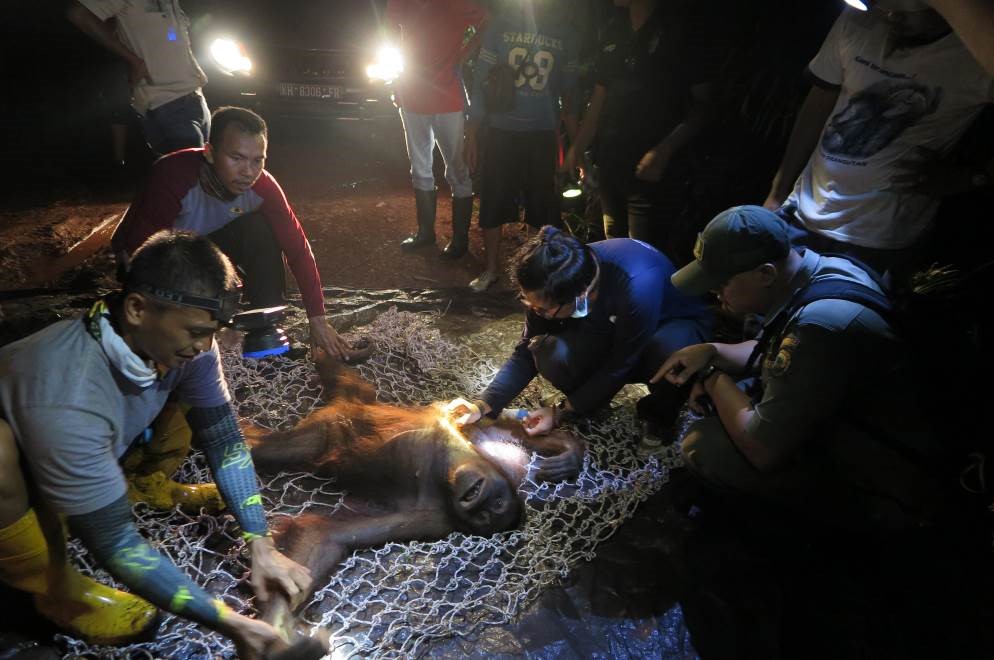
She was quickly transported to an open area where our vet Dr Dimas, examined her. Apart from a small scratch to her chest, she was in full health, weighing 45 kilos and was thought to be around 18 years-old. The scratch was cleaned and injected with long-acting antibiotics to prevent infection.
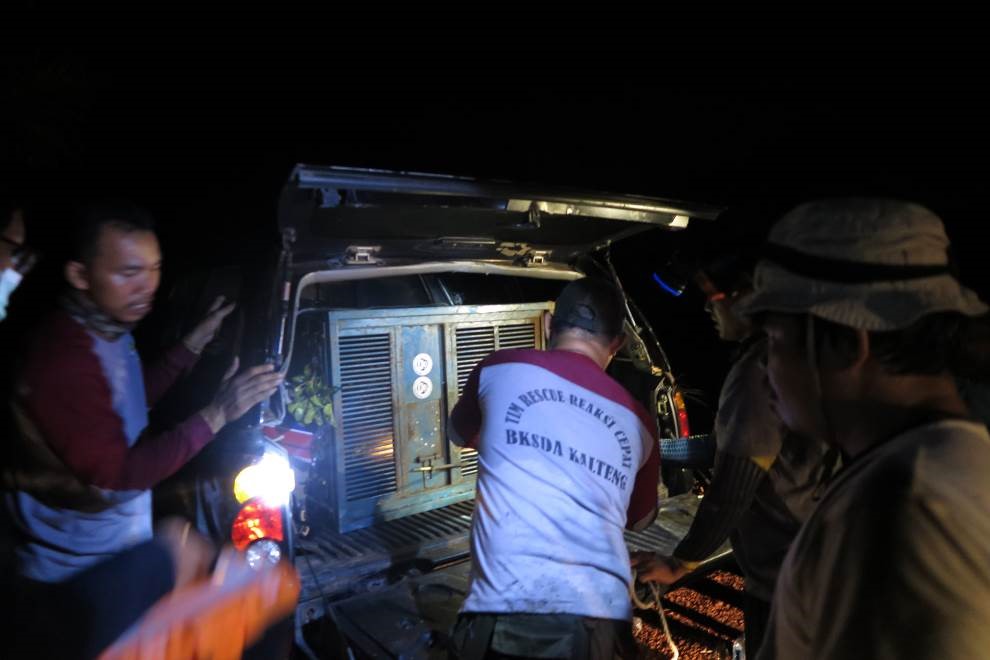
Two days later the orangutan was released in the Lamandau Widlife Reserve, on the opposite side of the river from Camp JL. We protect this forest reserve with guard posts and regular forest patrols to prevent and deter illegal activities.

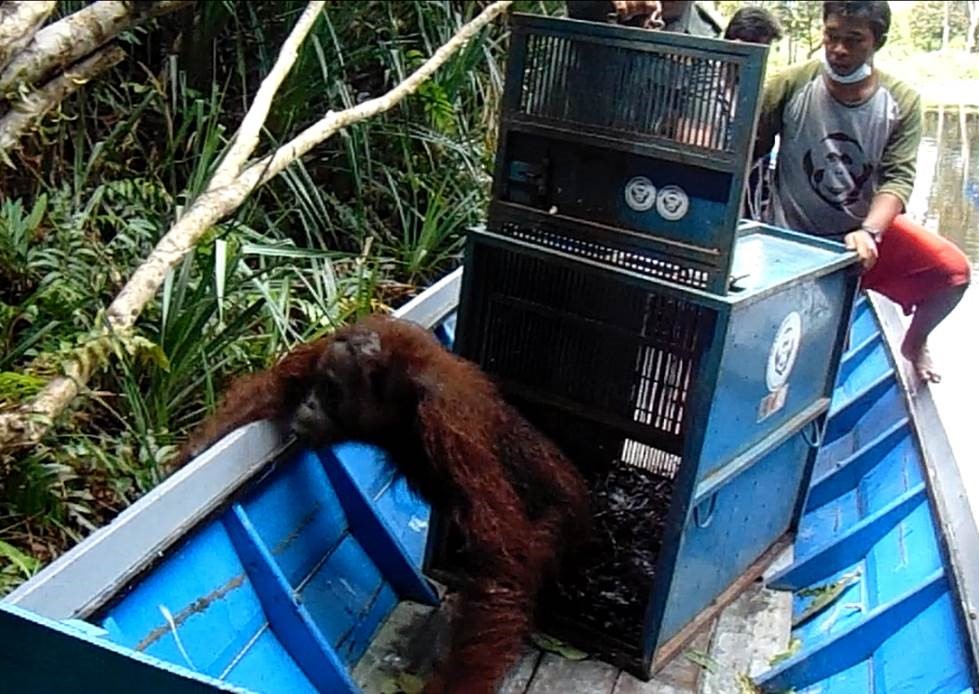
As soon as the transport cage door was opened she actively climbed into the nearby trees and disappeared into the forest.This, we hope, is her last encounter with humans.

The Lamandau Wildlife Reserve totals 158,144 acres of tropical forest and is home to a population of more than 500 orangutans. Half of these were reintroduced or translocated and given a second chance of survival in the wild. We must make sure they are stay safe. Please donate to our urgent appeal – DONATE TODAY
Stop habitat loss, stop orangutans being killed
In the last month we have heard disturbing reports about the cruel and brutal killing of two critically endangered Bornean orangutans. Sadly, our staff care for the victims, of these sort of actions, every day. We're still caring for Aan, shot 104 times and left permanently blind. Little Bumi, rescued last year, 8 pellets removed, his mother must have been shot and killed.
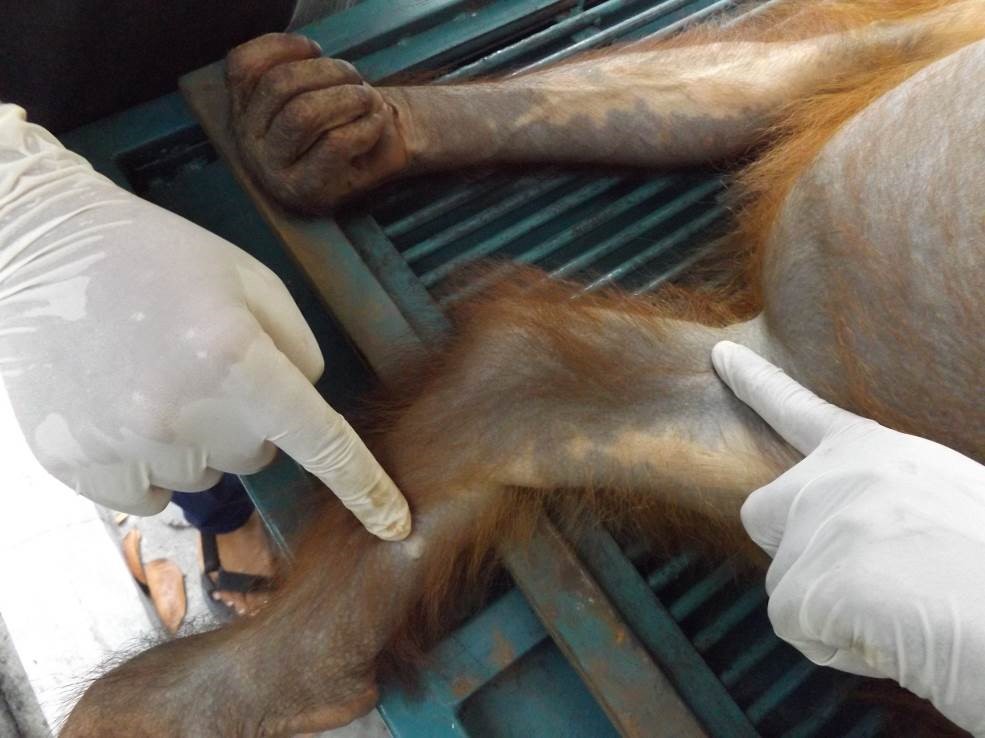
We ask ourselves, how could someone harm these gentle, intelligent and peaceful beings?
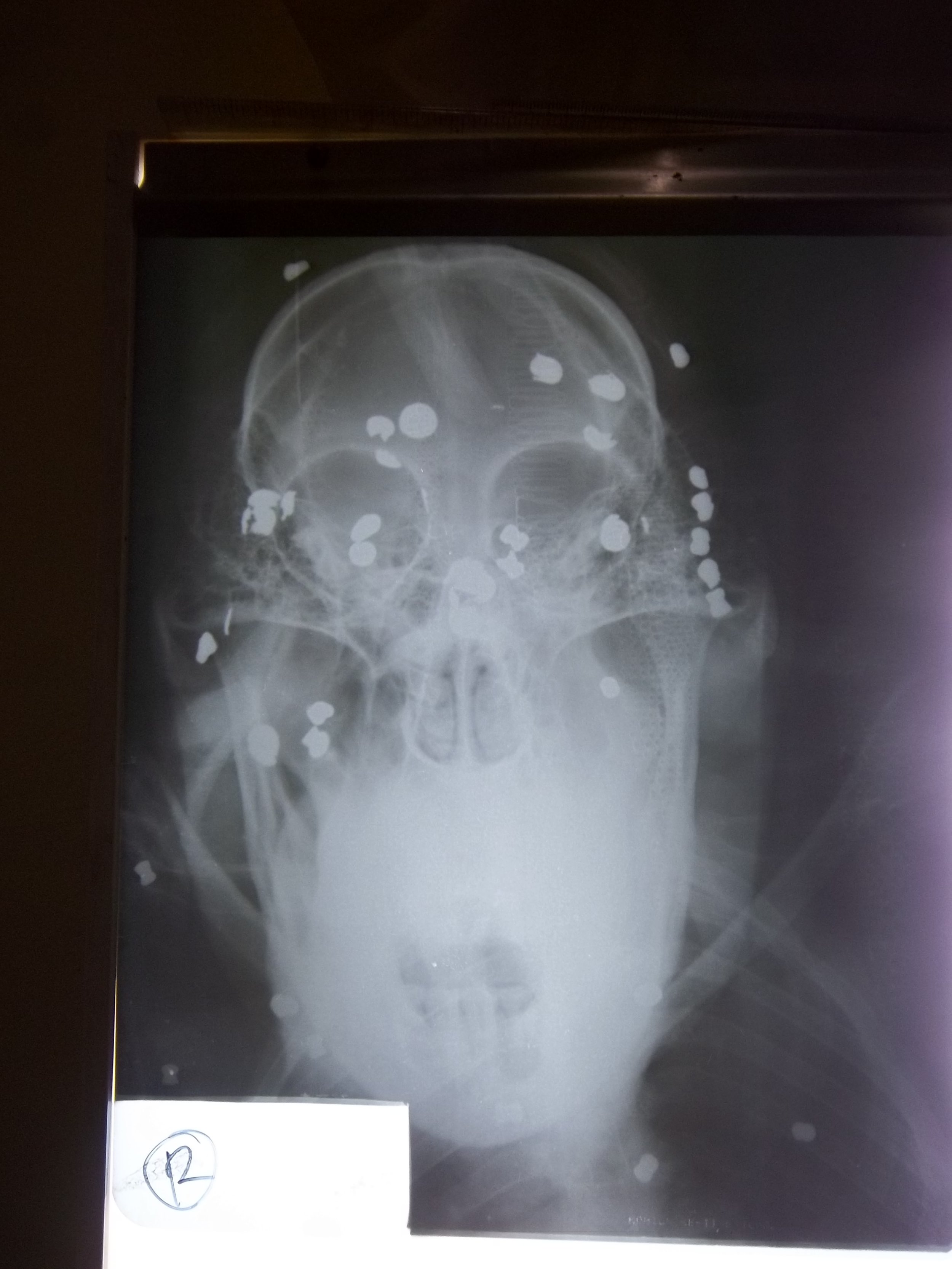
The killing of an orangutan is a visible threat, rightly generating shock and outrage. The invisible threat that forces orangutans into increasing contact with humans, onto oil-palm plantations or village farms, is habitat loss. We use the term invisible because habitat loss does not elicit the same level of response as an orangutan killing.
In the last month our guard post staff have tackled illegally lit fires and prevented them spreading, but still 30 hectares burnt. This week, they detected the second case this year of illegal logging, right on the boundary of the Lamandau Wildlife Reserve. This is meant to be strictly protected forest, it has a population of over 500 orangutans. We need to keep it protected and the orangutans safe.
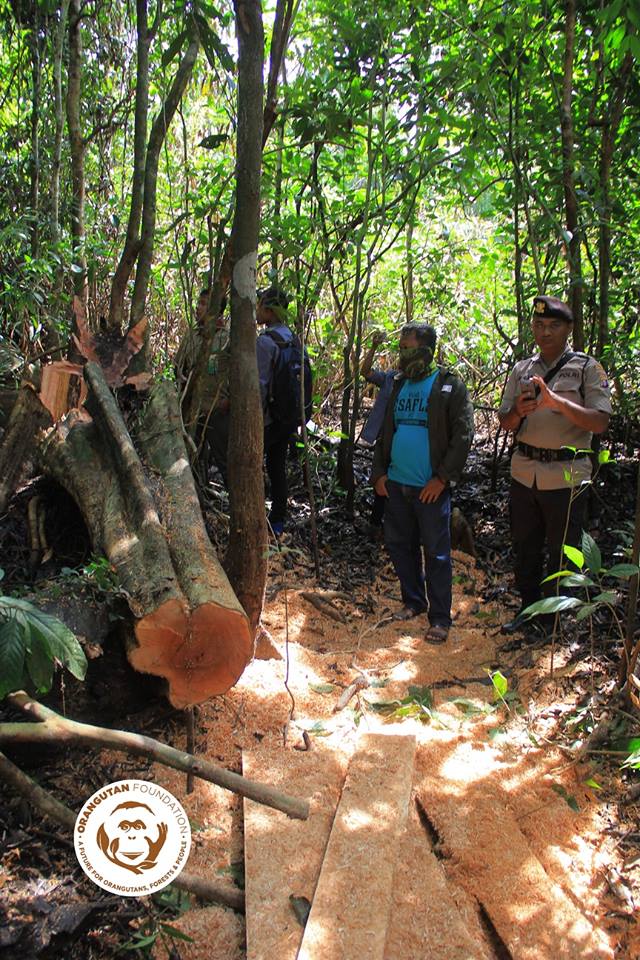
Why does the image of a fallen tree not also generate the same outrage? When forests are cleared, orangutans and hundreds of other species are harmed or even killed. Some survive, if they can move to another area of forest. This increases competition for resources and forces them into closer contact with humans. It is because we can’t see the immediate impact on orangutans and so our response is different.
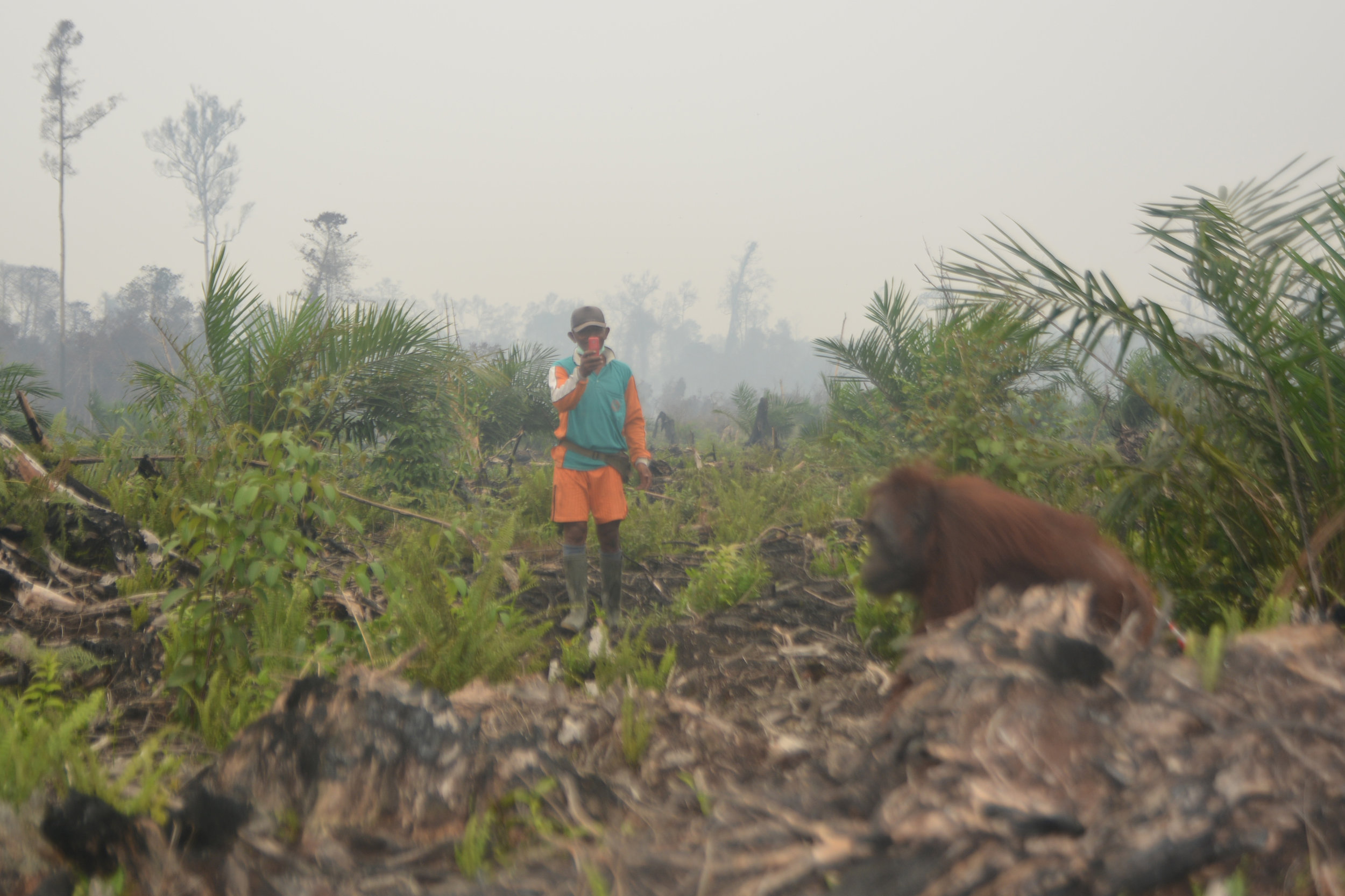
We need your help now, more than ever. Our guard post patrol staff require ongoing support to prevent illegal activities and further loss of orangutan habitat. The Lamandau Wildlife Reserve is huge, 158,144 acres of tropical forest (one acre is the approximate size of one football pitch). Our staff do a fabulous job patrolling such a large area but need to be supported.
Please help us to keep these vital forests standing and their precious inhabitants in wild. Please donate today.
If you can, please consider becoming a Guardian of Lamandau Wildlife Reserve, from £16.50 a month (the equivalent of 55p a day) you can make a significant difference. Thank you.
We thank the West Kotawaringin Police, KPHP Kotawaringin Barat, and BKSDA Kalteng for their joint patrols.
Baby orangutan born
We are delighted to announce the arrival of another baby orangutan born into the protected Lamandau Wildlife Reserve, Indonesian Borneo. Our staff believe the orangutan was born on 26th January. Mother, Holahonolulu (Hola for short) was seen with her new infant at Camp Gemini's feeding site. We think the father is likely to be Bangkal, the dominant male, as they were seen mating on several occasions.
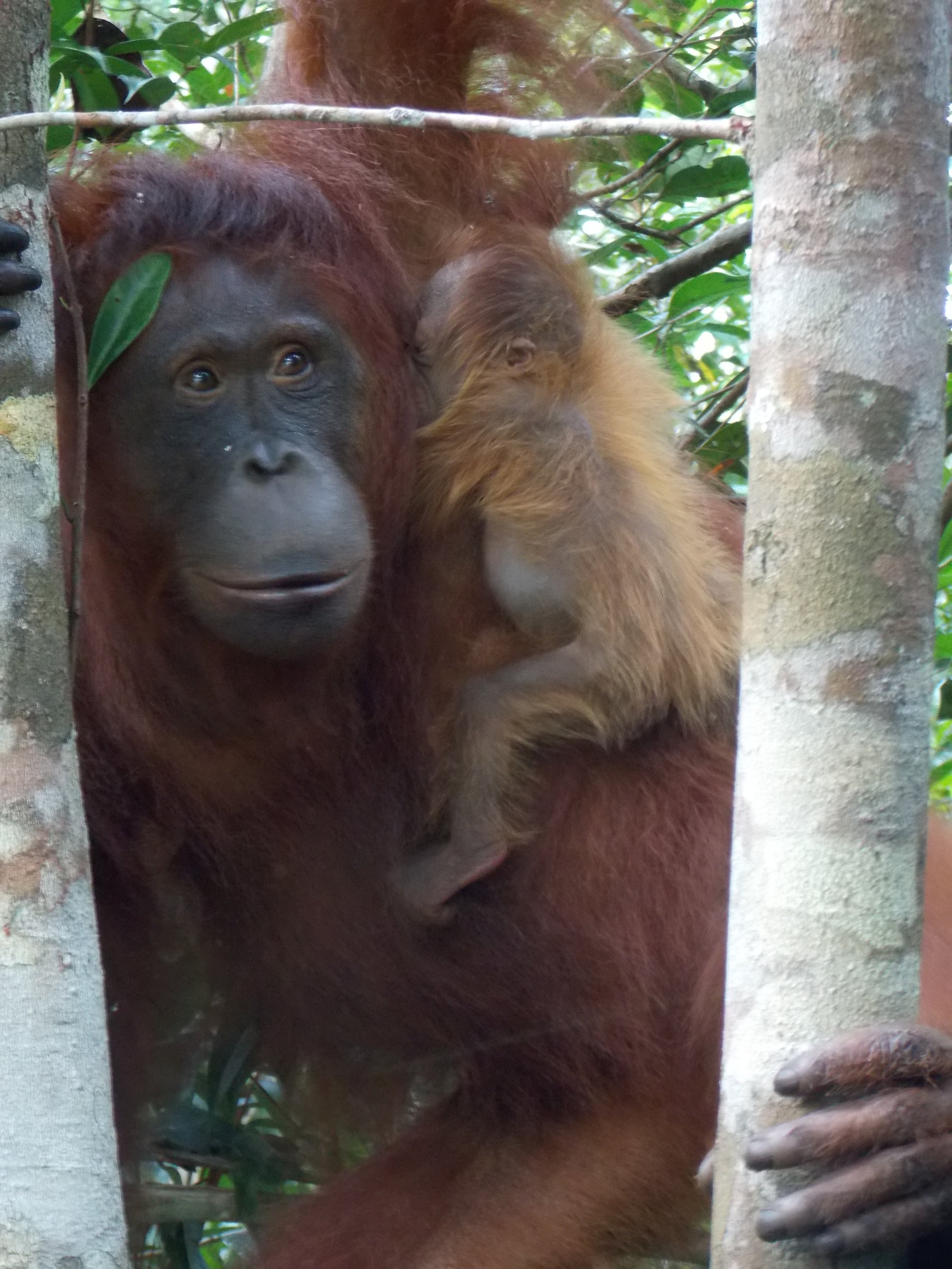

Both Hola and her baby looked healthy. Hola ate a lot of fruit, the extra energy needed for milk production. As yet, our staff could not tell what sex the baby was.
Hola was born in the wild in December 2004 and her mother was Huber. Huber was rehabilitated by OFI and was released into the Lamandau Wildlife Reserve in December 1999, but she has since passed away.
Our staff have yet to name Hola's new baby so we thought we would ask for your help. Send us your suggestions (leave a comment), it must start with an H and be a unisex name. We will decide on Monday 5th February.
Help us to ensure these orangutans remain in the wild and that their forest home stays protected. Click here to donate today!
Orangutan Foundation - a future for orangutans, forests & people
Vet's first orangutan rescue
The Orangutan Foundation is delighted to welcome Dimas Yuzrifar as its new vet, replacing Dr Steven, who has now returned to Bali. Being "thrown in at the deep end" is certainly how the first week has been for Dr Dimas! Last weekend we received reports of a wild orangutan in village forest. This was passed onto the government agency for wildlife, BKSDA SKW II Pangkalan Bun.
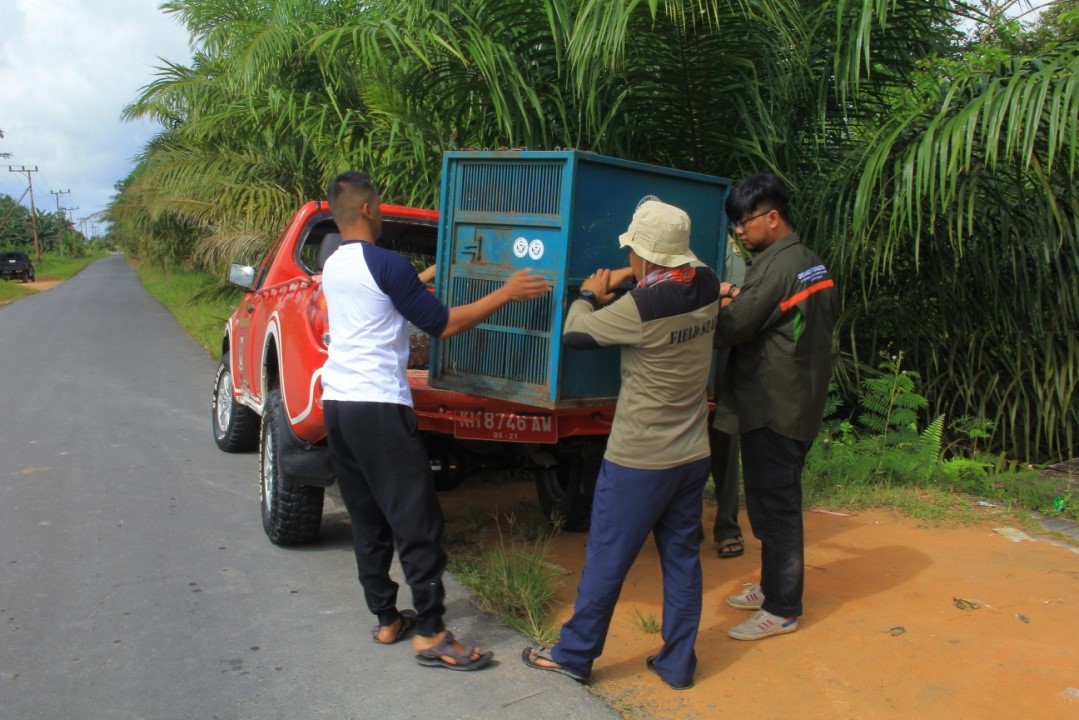
The orangutan was found close to oil palm, banana and rubber plantations owned by local residents. The villagers feared the orangutan would damage their crops and so BKSDA decided, in this case, to capture and move (translocate) the orangutan, to avoid any conflict arising. Dr Dimas managed to anesthetize the orangutan. After being caught the orangutan was identified as female with an estimated weight of around 25 kg. The next day after checking the orangutan was well and active she was released into the safety of the protected Lamandau Willdife Reserve.
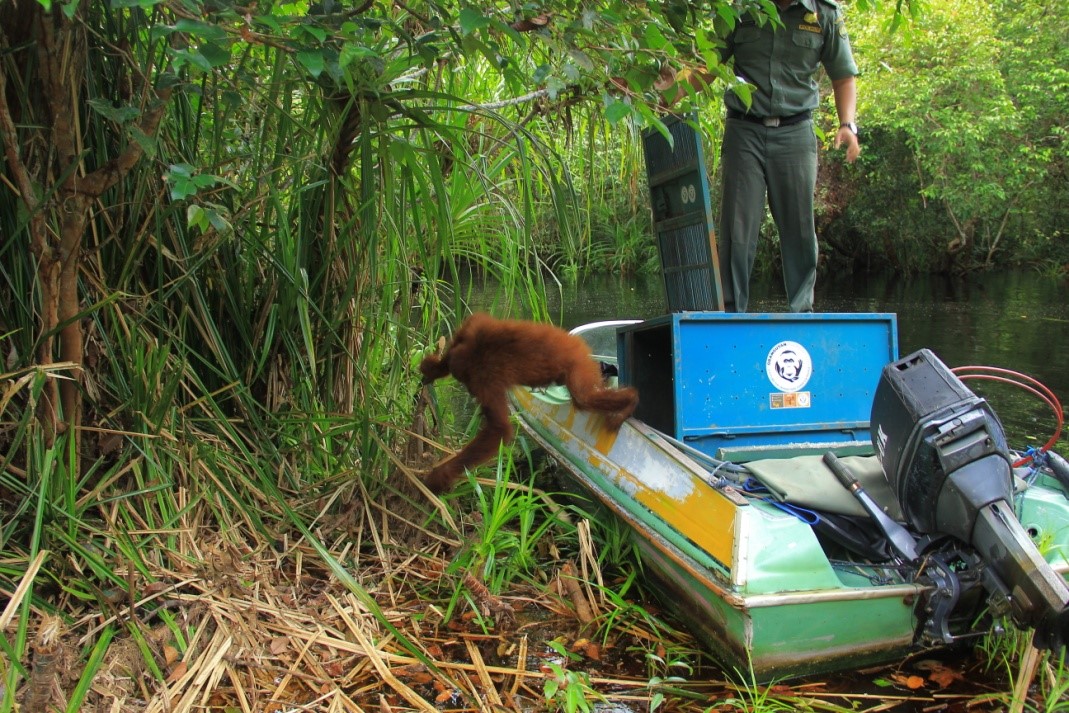
Watch this clip to see how quickly the orangutan leaves the transport cage and disappears into the forest.
After the busy weekend with the translocation, Dr Dimas also spent time meeting and checking up on the young orangutans in our release camps. Here's a clip of young Satria playing in his night-time enclosure.
Wonder what the next week will have in store?
Thank you for supporting our work.
Donate to help us keep the Lamandau Wildlife Reserve and its precious orangutans and wildlife protected. Click here to donate - thank you.



